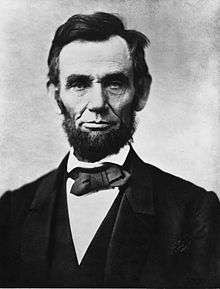Abraham Lincoln
Abraham Lincoln (/ˈlɪŋkən/;[2] February 12, 1809 – April 15, 1865) was an American statesman and lawyer who served as the 16th president of the United States (1861–1865). Lincoln led the nation through its greatest moral, constitutional, and political crisis in the American Civil War.[3][4] He preserved the Union, abolished slavery, strengthened the federal government, and modernized the U.S. economy.
Abraham Lincoln | |
|---|---|
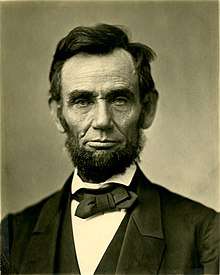 Lincoln in November 1863 | |
| 16th President of the United States | |
| In office March 4, 1861 – April 15, 1865 | |
| Vice President | Hannibal Hamlin Andrew Johnson |
| Preceded by | James Buchanan |
| Succeeded by | Andrew Johnson |
| Member of the U.S. House of Representatives from Illinois's 7th district | |
| In office March 4, 1847 – March 3, 1849 | |
| Preceded by | John Henry |
| Succeeded by | Thomas L. Harris |
| Member of the Illinois House of Representatives from Sangamon County | |
| In office December 1, 1834 – December 4, 1842 | |
| Personal details | |
| Born | February 12, 1809 Sinking Spring Farm, Kentucky, U.S. |
| Died | April 15, 1865 (aged 56) Washington, D.C., U.S. |
| Cause of death | Assassination (gunshot wound to the head) |
| Resting place | Lincoln Tomb |
| Political party | Whig (before 1854) Republican (1854–1864) National Union (1864–1865) |
| Height | 6 ft 4 in (193 cm)[1] |
| Spouse(s) | |
| Children |
|
| Mother | Nancy Hanks |
| Father | Thomas Lincoln |
| Signature | |
| Military service | |
| Allegiance | United States Illinois |
| Branch/service | Illinois Militia |
| Years of service | 1832 |
| Rank | Captain[lower-alpha 1] Private[lower-alpha 1] |
| Battles/wars | American Indian Wars
|
| ||
|---|---|---|
President of the United States
First term
Second term
Presidential elections
Assassination and legacy
 |
||
Lincoln was born in poverty in a log cabin and was raised on the frontier primarily in Indiana. He was self-educated and became a lawyer, Whig Party leader, Illinois state legislator, and U.S. Congressman from Illinois. In 1849 he returned to his law practice but became vexed by the opening of additional lands to slavery as a result of the Kansas–Nebraska Act. He reentered politics in 1854, becoming a leader in the new Republican Party, and he reached a national audience in the 1858 debates against Stephen Douglas. Lincoln ran for President in 1860, sweeping the North in victory. Pro-slavery elements in the South equated his success with the North's rejection of their right to practice slavery, and southern states began seceding from the union. To secure its independence, the new Confederate States of America fired on Fort Sumter, a U.S. fort in the South, and Lincoln called up forces to suppress the rebellion and restore the Union.
As the leader of moderate Republicans, Lincoln stood in the center of the factions with friends and opponents on both sides. War Democrats rallied a large faction of former opponents into his moderate camp, but they were countered by Radical Republicans, who demanded harsh treatment of the Southern traitors. Anti-war Democrats (called "Copperheads") despised him. There were irreconcilable pro-Confederate elements who plotted his assassination. Lincoln managed the factions by pitting them against each other, by carefully distributing political patronage, and by appealing to the American people.[5]:65–87 His Gettysburg Address became a historic clarion call for nationalism, republicanism, equal rights, liberty, and democracy. Lincoln scrutinized the strategy and tactics in the war effort, including the selection of generals and the naval blockade of the South's trade. He suspended habeas corpus, and he averted British intervention by defusing the Trent Affair. He engineered the end to slavery with his Emancipation Proclamation and his order that the Army protect escaped slaves. He also encouraged border states to outlaw slavery, and promoted the Thirteenth Amendment to the United States Constitution which outlawed slavery across the country.
Lincoln managed his own successful re-election campaign. He sought to reconcile the war-torn nation by exonerating the secessionists. On April 14, 1865, just days after the war's end at Appomattox, he was enjoying a night at the theatre with his wife Mary when he was assassinated by Confederate sympathizer John Wilkes Booth. Lincoln's marriage had produced four sons, two of whom preceded him in death, with severe emotional impact upon him and Mary. Lincoln is remembered as the United States' martyr hero, and he is consistently ranked both by scholars[6] and the public[7] as the greatest U.S. president.
Family and childhood
Early life
Abraham Lincoln was born on February 12, 1809, the second child of Thomas Lincoln and Nancy Hanks Lincoln, in a one-room log cabin on Sinking Spring Farm near Hodgenville, Kentucky.[8]:20–22 He was a descendant of Samuel Lincoln, an Englishman who migrated from Hingham, Norfolk, to its namesake, Hingham, Massachusetts, in 1638. The family then migrated west, passing through New Jersey, Pennsylvania, and Virginia.[9]:3,4 Lincoln's paternal grandfather and namesake, Captain Abraham Lincoln, moved the family from Virginia to Jefferson County, Kentucky and was killed in an Indian raid in 1786.[9]:4 His children, including eight-year-old Thomas, Abraham's father, witnessed the attack.[8]:21[lower-alpha 2] Thomas then worked at odd jobs in Kentucky and Tennessee before the family settled in Hardin County, Kentucky in the early 1800s.[8]:21
The heritage of Lincoln's mother Nancy remains unclear, but it is widely assumed that she was the daughter of Lucy Hanks.[11]:79 Thomas and Nancy married on June 12, 1806, in Washington County, and moved to Elizabethtown, Kentucky.[9]:9 They had three children: Sarah, Abraham, and Thomas – who died in infancy.[9]:9–10
Thomas Lincoln bought or leased farms in Kentucky before losing all but 200 acres (81 ha) of his land in court disputes over property titles.[12]:20 In 1816, the family moved to Indiana where the land surveys and titles were more reliable.[9]:13 Indiana was a "free" (non-slaveholding) territory, and they settled in an "unbroken forest"[9]:26 in Hurricane Township, Perry County, Indiana.[9]:16 and 43 [lower-alpha 3] In 1860, Lincoln noted that the family's move to Indiana was "partly on account of slavery", but mainly due to land title difficulties.[12]:20[8]:23–24

In Kentucky and Indiana, Thomas worked as a farmer, cabinetmaker, and carpenter.[11]:34, 156 At various times, he owned farms, livestock and town lots, paid taxes, sat on juries, appraised estates, and served on county patrols. Thomas and Nancy were members of a Separate Baptists church, which forbade alcohol, dancing, and slavery.[8]:22–24
Overcoming financial challenges, Thomas eventually obtained clear title to 80 acres (32 ha) of land in what became known as the Little Pigeon Creek Community in Indiana.[11]:24, 104
Mother's death
On October 5, 1818, Nancy Lincoln died of milk sickness, leaving 11-year-old Sarah in charge of a household that included her father, 9-year-old Abraham, and Dennis Hanks, Nancy's 19-year-old orphaned cousin.[11]:22–23, 77 Ten years later, on January 20, 1828, Sarah died while giving birth to a stillborn son; Lincoln was distraught over his sister's death.[8]:34, 116[13]
On December 2, 1819, Thomas married Sarah "Sally" Bush Johnston, a widow from Elizabethtown, Kentucky, with three children of her own.[11]:23, 83 Abraham became close to his stepmother, whom he referred to as "Mother".[8]:26–27 Lincoln disliked the hard labor associated with farm life. He was called lazy for all his "reading, scribbling, writing, ciphering, writing Poetry, etc.".[14]:25, 31, 47 His stepmother acknowledged he did not enjoy "physical labor", but loved to read.[11]:66
Education and move to Illinois
Lincoln was primarily self-educated, with intermittent formal schooling from travelling teachers of less than 12 months aggregate;[11]:10, 33 he became an avid reader and retained a lifelong interest in learning.[15]:110 Family, neighbors, and schoolmates recalled that his reading included the King James Bible, Aesop's Fables, John Bunyan's The Pilgrim's Progress, Daniel Defoe's Robinson Crusoe, Mason Locke Weems's The Life of Washington, and The Autobiography of Benjamin Franklin.[8]:29–31, 38–43
As a teen, Lincoln took responsibility for chores, and customarily gave his father all earnings from work outside the home until age 21.[8]:30–33 Lincoln was tall, strong, and athletic and became adept at using an ax.[9]:134–35 He was known for his strength and audacity after winning a wrestling match with the renowned leader of a group of ruffians known as "the Clary's Grove boys."[8]:41
In March 1830, partly out of fear of another milk sickness outbreak, several members of the extended Lincoln family, including Thomas, moved west to Illinois, a free state, and settled in Macon County, 10 miles (16 km) west of Decatur.[8]:36 [lower-alpha 4] Abraham then became increasingly distant from Thomas, in part due to his father's lack of education.[11]:71 Nevertheless, he occasionally lent Thomas money.[8]:28, 152 In 1831, as Thomas and other family prepared to move to a new homestead in Coles County, Illinois, Abraham struck out on his own.[16]:15–17 He made his home in New Salem, Illinois for six years.[17]:23–53 Lincoln and some friends took goods by flatboat to New Orleans, Louisiana, where he was first exposed to slavery.[12]:22–23[8]:38
Marriage and children
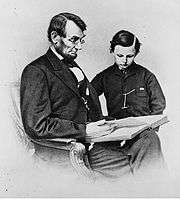
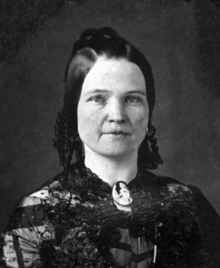
Lincoln's first romantic interest was Ann Rutledge, whom he met when he first moved to New Salem; by 1835, they were in a relationship but not formally engaged.[18] She died on August 25, 1835, most likely of typhoid fever.[8]:55–58 In the early 1830s, he met Mary Owens from Kentucky.[17]:56–57, 69–70
Late in 1836, Lincoln agreed to a match with Owens if she returned to New Salem. Owens arrived in November 1836, and Lincoln courted her for a time; however, they both had second thoughts. On August 16, 1837, Lincoln wrote Owens a letter suggesting he would not blame her if she ended the relationship; she never replied.[8]:67
In 1840, Lincoln became engaged to Mary Todd, a daughter of Robert Smith Todd, a wealthy slave owner in Lexington, Kentucky.[19]:3 They met in Springfield, Illinois, in December 1839 and were engaged a year later.[8]:80–86 A wedding set for January 1, 1841, was canceled at Lincoln's request, but they reconciled and married on November 4, 1842, in the Springfield mansion of Mary's sister.[12]:46–51 While anxiously preparing for the nuptials, Lincoln was asked where he was going and replied, "To hell, I suppose."[8]:93 In 1844, the couple bought a house in Springfield near Lincoln's law office; Mary kept house with the help of a relative and hired servant.[20]:142
Lincoln was an affectionate husband and father of four sons although, due to his work, he was regularly absent from home. The oldest, Robert Todd Lincoln, was born in 1843 and was Lincoln's only child to live to maturity. Edward Baker Lincoln (Eddie), born in 1846, died February 1, 1850, probably of tuberculosis. Lincoln's third son, "Willie" Lincoln was born on December 21, 1850, and died of fever at the White House on February 20, 1862. The youngest, Thomas "Tad" Lincoln, was born on April 4, 1853, and survived his father but died of heart failure at age 18 on July 16, 1871.[14]:179–181, 476 [lower-alpha 5] Lincoln "was remarkably fond of children,"[14]:126 and the Lincolns were not considered to be strict with their own.[20]:120 In fact, Lincoln's law partner William H. Herndon would grow irritated when Lincoln would bring his children to the law office. Their father, it seemed, was often too absorbed in his work to notice his children's behavior. Herndon recounted, "I have felt many and many a time that I wanted to wring their little necks, and yet out of respect for Lincoln I kept my mouth shut. Lincoln did not note what his children were doing or had done."[22]
The deaths of their sons, Eddie and Willie, had profound effects on both parents. Lincoln also suffered from "melancholy," a condition now thought to be clinical depression.[23] Later in life, Mary struggled with the stresses of losing her husband and sons, and Robert committed her temporarily to a mental health asylum in 1875.[24]:341
Early career and militia service
In 1832, Lincoln joined with a partner, Denton Offutt, in the purchase of a general store on credit in New Salem.[25] Although the economy was booming, the business struggled and Lincoln eventually sold his share. That March he entered politics, running for the Illinois General Assembly, advocating navigational improvements on the Sangamon River. He could draw crowds as a raconteur, but he lacked the requisite formal education, powerful friends, and money, and lost the election.[8]:41[26]
Lincoln briefly interrupted his campaign to serve as a captain in the Illinois Militia during the Black Hawk War.[27]:86–95 When he returned to his campaign and first speech, he observed a supporter in the crowd under attack, grabbed the assailant by his "neck and the seat of his trousers" and tossed him.[8]:46 Lincoln finished eighth out of 13 candidates (the top four were elected), though he received 277 of the 300 votes cast in the New Salem precinct.[27]:114–116
Lincoln served as New Salem's postmaster and later as county surveyor, but continued his voracious reading, and he decided to become a lawyer. He taught himself the law, with Blackstone's Commentaries, saying later of the effort, "I studied with nobody."[8]:53–55
Illinois state legislature
Lincoln's second state house campaign in 1834, this time as a Whig, was a success over a powerful Whig opponent.[14]:59 Then followed his four terms in the Illinois House of Representatives for Sangamon County.[28]:283 He championed construction of the Illinois and Michigan Canal, and later was a Canal Commissioner.[29] He voted to expand suffrage beyond white landowners to all white males, but adopted a "free soil" stance opposing both slavery and abolition.[28]:130 In 1837 he declared, "[The] Institution of slavery is founded on both injustice and bad policy, but the promulgation of abolition doctrines tends rather to increase than abate its evils."[8]:134 He echoed Henry Clay's support for the American Colonization Society which advocated a program of abolition in conjunction with settling freed slaves in Liberia.[30]:17–19, 67
Admitted to the Illinois bar in 1836,[8]:64 he moved to Springfield and began to practice law under John T. Stuart, Mary Todd's cousin.[14]:71, 79, 108 Lincoln emerged as a formidable trial combatant during cross-examinations and closing arguments. He partnered several years with Stephen T. Logan, and in 1844 began his practice with William Herndon, "a studious young man."[8]:17
U.S. House of Representatives, 1847–1849

True to his record, Lincoln professed to friends in 1861 to be "an old line Whig, a disciple of Henry Clay."[8]:222 Their party favored economic modernization in banking, tariffs to fund internal improvements including railroads, and urbanization.[31]:137–153
In 1843 Lincoln sought the Whig nomination for Illinois's 7th district seat in the U.S. House of Representatives; he was defeated by John J. Hardin though he prevailed with the party in limiting Hardin to one term. Lincoln not only pulled off his strategy of gaining the nomination in 1846, but he was also indeed elected to the seat in the House. He was the only Whig in the Illinois delegation, but as dutiful as any, participating in almost all votes and making speeches that toed the party line.[32]:79 Lincoln teamed with Joshua R. Giddings on a bill to abolish slavery in the District of Columbia with compensation for the owners, enforcement to capture fugitive slaves, and a popular vote on the matter. He dropped the bill when it eluded Whig support.[33]:54[30]:57
Committee assignments
- Committee on Post Office and Post Roads
- Committee on Expenditures in the War Department[34]
Political views
On foreign and military policy, Lincoln spoke against the Mexican–American War, which he imputed to President James K. Polk's desire for "military glory—that attractive rainbow, that rises in showers of blood."[35]:181–183 He supported the Wilmot Proviso, a failed proposal to ban slavery in any U.S. territory won from Mexico.[36]:63
Lincoln emphasized his opposition to Polk by drafting and introducing his Spot Resolutions. The war had begun with a Mexican slaughter of American soldiers in territory disputed by Mexico, and Polk insisted that Mexican soldiers had "invaded our territory and shed the blood of our fellow-citizens on our soil."[32]:79–80 Lincoln demanded that Polk show Congress the exact spot on which blood had been shed and prove that the spot was on American soil.[37]:199–202 The resolution was ignored in both the Congress and the national papers, and it cost Lincoln political support in his district. One Illinois newspaper derisively nicknamed him "spotty Lincoln.:202[38] Lincoln later regretted some of his statements, especially his attack on presidential war-making powers.[8]:128
Lincoln had pledged in 1846 to serve only one term in the House. Realizing Clay was unlikely to win the presidency, he supported General Zachary Taylor for the Whig nomination in the 1848 presidential election.[8]:124–126 Taylor won and Lincoln hoped in vain to be appointed Commissioner of the General Land Office.[8]:140 The administration offered to appoint him secretary or governor of the Oregon Territory as consolation.[39] This distant territory was a Democratic stronghold, and acceptance of the post would have disrupted his legal and political career in Illinois, so he declined and resumed his law practice.[33]:55–57
Prairie lawyer
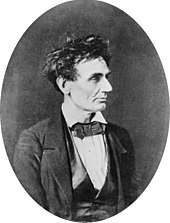
In his Springfield practice Lincoln handled "every kind of business that could come before a prairie lawyer."[8]:96 Twice a year he appeared for 10 consecutive weeks in county seats in the midstate county courts; this continued for 16 years.[8]:105–106, 158 Lincoln handled transportation cases in the midst of the nation's western expansion, particularly river barge conflicts under the many new railroad bridges. As a riverboat man, Lincoln initially favored those interests, but ultimately represented whoever hired him.[8]:142–143 He later represented a bridge company against a riverboat company in a landmark case involving a canal boat that sank after hitting a bridge.[40][41] In 1849, he received a patent for a flotation device for the movement of boats in shallow water. The idea was never commercialized, but it made Lincoln the only president to hold a patent.[14]:163[42]
Lincoln appeared before the Illinois Supreme Court in 175 cases; he was sole counsel in 51 cases, of which 31 were decided in his favor.[43]:440 From 1853 to 1860, one of his largest clients was the Illinois Central Railroad.[8]:155–156, 196–197 His legal reputation gave rise to the nickname "Honest Abe".[44]
Lincoln argued in an 1858 criminal trial, defending William "Duff" Armstrong, who was on trial for the murder of James Preston Metzker.[8]:150–151 The case is famous for Lincoln's use of a fact established by judicial notice to challenge the credibility of an eyewitness. After an opposing witness testified to seeing the crime in the moonlight, Lincoln produced a Farmers' Almanac showing the moon was at a low angle, drastically reducing visibility. Armstrong was acquitted.[8]:150–151
Leading up to his presidential campaign, Lincoln elevated his profile in an 1859 murder case, with his defense of Simeon Quinn "Peachy" Harrison who was the third cousin; Harrison was also the grandson of Lincoln's political opponent, Rev. Peter Cartwright.[45]:480 Harrison was charged with the murder of Greek Crafton who, as he lay dying of his wounds, confessed to Cartwright that he had provoked Harrison.[46] Lincoln angrily protested the judge's initial decision to exclude Cartwright's testimony about the confession as inadmissible hearsay. Lincoln argued that the testimony involved a dying declaration and was not subject to the hearsay rule. Instead of holding Lincoln in contempt of court as expected, the judge, a Democrat, reversed his ruling and admitted the testimony into evidence, resulting in Harrison's acquittal.[8]:150–151
Republican politics 1854–1860
Emergence as Republican leader
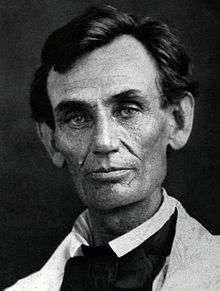
The debate over the status of slavery in the territories failed to alleviate tensions between the slave-holding South and the free North, with the failure of the Compromise of 1850, a legislative package designed to address the issue.[14]:175–176 In his 1852 eulogy for Clay, Lincoln highlighted the latter's support for gradual emancipation and opposition to "both extremes" on the slavery issue.[14]:182–185 As the slavery debate in the Nebraska and Kansas territories became particularly acrimonious, Illinois Senator Stephen A. Douglas proposed popular sovereignty as a compromise; the measure would allow the electorate of each territory to decide the status of slavery. The legislation alarmed many Northerners, who sought to prevent the resulting spread of slavery, but Douglas's Kansas–Nebraska Act narrowly passed Congress in May 1854.[14]:188–190
Lincoln did not comment on the act until months later in his "Peoria Speech" in October 1854. Lincoln then declared his opposition to slavery which he repeated en route to the presidency.[17]:148–152 He said the Kansas Act had a "declared indifference, but as I must think, a covert real zeal for the spread of slavery. I cannot but hate it. I hate it because of the monstrous injustice of slavery itself. I hate it because it deprives our republican example of its just influence in the world ..."[37]:255 Lincoln's attacks on the Kansas–Nebraska Act marked his return to political life.[14]:203–205
Nationally, the Whigs were irreparably split by the Kansas–Nebraska Act and other efforts to compromise on the slavery issue. Reflecting on the demise of his party, Lincoln wrote in 1855, "I think I am a Whig, but others say there are no Whigs, and that I am an abolitionist...I do no more than oppose the extension of slavery."[14]:215–216 The new Republican Party was formed as a northern party dedicated to antislavery, drawing from the antislavery wing of the Whig Party, and combining Free Soil, Liberty, and antislavery Democratic Party members,[47]:38–39 Lincoln resisted early Republican entreaties, fearing that the new party would become a platform for extreme abolitionists.[14]:203–204 Lincoln held out hope for rejuvenating the Whigs, though he lamented his party's growing closeness with the nativist Know Nothing movement.[14]:191–194
In 1854 Lincoln was elected to the Illinois legislature but declined to take his seat. The year's elections showed the strong opposition to the Kansas–Nebraska Act, and in the aftermath, Lincoln sought election to the United States Senate.[14]:203–205 At that time, senators were elected by the state legislature.[32]:119 After leading in the first six rounds of voting, he was unable to obtain a majority. Lincoln instructed his backers to vote for Lyman Trumbull. Trumbull was an antislavery Democrat, and had received few votes in the earlier ballots; his supporters, also antislavery Democrats, had vowed not to support any Whig. Lincoln's decision to withdraw enabled his Whig supporters and Trumbull's antislavery Democrats to combine and defeat the mainstream Democratic candidate, Joel Aldrich Matteson.[14]:205–208
1856 campaign
Violent political confrontations in Kansas continued, and opposition to the Kansas–Nebraska Act remained strong throughout the North. As the 1856 elections approached, Lincoln joined the Republicans and attended the Bloomington Convention, which formally established the Illinois Republican Party. The convention platform endorsed Congress's right to regulate slavery in the territories and backed the admission of Kansas as a free state. Lincoln gave the final speech of the convention supporting the party platform and called for the preservation of the Union.[14]:216–221 At the June 1856 Republican National Convention, though Lincoln received support to run as vice president, John C. Frémont and William Dayton comprised the ticket, which Lincoln supported throughout Illinois. The Democrats nominated former Secretary of State James Buchanan and the Know-Nothings nominated former Whig President Millard Fillmore.[14]:224–228 Buchanan prevailed, while Republican William Henry Bissell won election as Governor of Illinois, and Lincoln became a leading Republican in Illinois.[14]:229–230[lower-alpha 6]
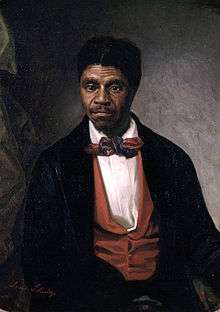
Dred Scott v. Sanford
Dred Scott was a slave whose master took him from a slave state to a free territory under the Missouri Compromise. After Scott was returned to the slave state he petitioned a federal court for his freedom. His petition was denied in Dred Scott v. Sandford (1857); Supreme Court Chief Justice Roger B. Taney in the decision wrote that blacks were not citizens and derived no rights from the Constitution. While many Democrats hoped that Dred Scott would end the dispute over slavery in the territories, the decision sparked further outrage in the North.[14]:236–238 Lincoln denounced it as the product of a conspiracy of Democrats to support the Slave Power.[48]:69–110 He argued the decision was at variance with the Declaration of Independence; he said that while the founding fathers did not believe all men equal in every respect, they believed all men were equal "in certain inalienable rights, among which are life, liberty, and the pursuit of happiness".[49]:299–300
Lincoln–Douglas debates and Cooper Union speech
In 1858 Douglas was up for re-election in the U.S. Senate, and Lincoln hoped to defeat him. Many in the party felt that a former Whig should be nominated in 1858, and Lincoln's 1856 campaigning and support of Trumbull had earned him a favor.[14]:247–248 Some eastern Republicans supported Douglas from his opposition to the Lecompton Constitution and admission of Kansas as a slave state.[32]:138–139 Many Illinois Republicans resented this eastern interference. For the first time, Illinois Republicans held a convention to agree upon a Senate candidate, and Lincoln won the nomination with little opposition.[14]:247–250
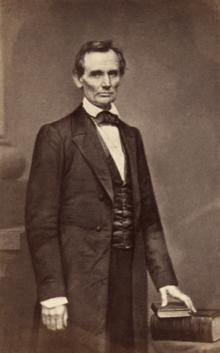
Accepting the nomination, Lincoln delivered his House Divided Speech, with the biblical reference Mark 3:25, "A house divided against itself cannot stand. I believe this government cannot endure permanently half slave and half free. I do not expect the Union to be dissolved—I do not expect the house to fall—but I do expect it will cease to be divided. It will become all one thing, or all the other."[14]:251 The speech created a stark image of the danger of disunion.[33]:98 The stage was then set for the election of the Illinois legislature which would, in turn, select Lincoln or Douglas.[8]:209 When informed of Lincoln's nomination, Douglas stated, "[Lincoln] is the strong man of the party ... and if I beat him, my victory will be hardly won."[14]:257–258
The Senate campaign featured seven debates between the two. These were the most famous political debates in American history; they had an atmosphere akin to a prizefight and drew crowds in the thousands.[8]:214–218 The principals stood in stark contrast both physically and politically. Lincoln warned that Douglas'"Slave Power" was threatening the values of republicanism, and accused Douglas of distorting the Founding Fathers' premise that all men are created equal. Douglas emphasized his Freeport Doctrine, that local settlers were free to choose whether to allow slavery, and accused Lincoln of having joined the abolitionists.[8]:214–224 Lincoln's argument assumed a moral tone, as he claimed Douglas represented a conspiracy to promote slavery. Douglas's argument was more legal, claiming that Lincoln was defying the authority of the U.S. Supreme Court in the Dred Scott decision.[8]:223

Though the Republican legislative candidates won more popular votes, the Democrats won more seats, and the legislature re-elected Douglas. Lincoln's articulation of the issues gave him a national political presence.[50]:89–90 In May 1859, Lincoln purchased the Illinois Staats-Anzeiger, a German-language newspaper that was consistently supportive; most of the state's 130,000 German Americans voted Democratic but the German-language paper mobilized Republican support.[8]:242, 412 In the aftermath of the 1858 election, newspapers frequently mentioned Lincoln as a potential Republican presidential candidate, rivaled by William H. Seward, Salmon P. Chase, Edward Bates, and Simon Cameron. While Lincoln was popular in the Midwest, he lacked support in the Northeast, and was unsure whether to seek the office.[14]:291–293 In January 1860, Lincoln told a group of political allies that he would accept the nomination if offered, and in the following months several local papers endorsed his candidacy.[14]:307–308
On February 27, 1860, powerful New York Republicans invited Lincoln to give a speech at Cooper Union, in which he argued that the Founding Fathers had little use for popular sovereignty and had repeatedly sought to restrict slavery. He insisted that morality required opposition to slavery, and rejected any "groping for some middle ground between the right and the wrong".[49]:473 Many in the audience thought he appeared awkward and even ugly.[36]:108–111 But Lincoln demonstrated intellectual leadership that brought him into contention. Journalist Noah Brooks reported, "No man ever before made such an impression on his first appeal to a New York audience."[50]:97[36]:157
Historian David Herbert Donald described the speech as a "superb political move for an unannounced candidate, to appear in one rival's (Seward) own state at an event sponsored by the second rival's (Chase) loyalists, while not mentioning either by name during its delivery".[8]:240 In response to an inquiry about his ambitions, Lincoln said, "The taste is in my mouth a little."[8]:241
1860 presidential election
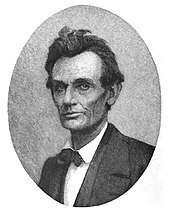
On May 9–10, 1860, the Illinois Republican State Convention was held in Decatur.[8]:244 Lincoln's followers organized a campaign team led by David Davis, Norman Judd, Leonard Swett, and Jesse DuBois, and Lincoln received his first endorsement.[32]:175–176 Exploiting his embellished frontier legend (clearing land and splitting fence rails), Lincoln's supporters adopted the label of "The Rail Candidate".[8]:245 In 1860, Lincoln described himself: "I am in height, six feet, four inches, nearly; lean in flesh, weighing, on an average, one hundred and eighty pounds; dark complexion, with coarse black hair, and gray eyes."[51] Michael Martinez wrote about the effective imaging of Lincoln by his campaign. At times he was presented as the plain-talking "Rail Splitter" and at other times he was "Honest Abe," unpolished but trustworthy.[52]
On May 18, at the Republican National Convention in Chicago, Lincoln won the nomination on the third ballot, beating candidates such as Seward and Chase. A former Democrat, Hannibal Hamlin of Maine, was nominated for Vice President to balance the ticket. Lincoln's success depended on his campaign team, his reputation as a moderate on the slavery issue, and his strong support for internal improvements and the tariff.[53]:609–629 Pennsylvania put him over the top, led by the state's iron interests who were reassured by his tariff support.[54]:50–55 Lincoln's managers had focused on this delegation while honoring Lincoln's dictate to "Make no contracts that bind me".[8]:247–250
As the Slave Power tightened its grip on the national government, most Republicans agreed with Lincoln that the North was the aggrieved party. Throughout the 1850s, Lincoln had doubted the prospects of civil war, and his supporters rejected claims that his election would incite secession.[31]:10, 13, 18 When Douglas was selected as the candidate of the Northern Democrats, delegates from eleven slave states walked out of the Democratic convention; they opposed Douglas's position on popular sovereignty, and selected incumbent Vice President John C. Breckinridge as their candidate.[8]:253 A group of former Whigs and Know Nothings formed the Constitutional Union Party and nominated John Bell of Tennessee. Lincoln and Douglas competed for votes in the North, while Bell and Breckinridge primarily found support in the South.[14]:247–248
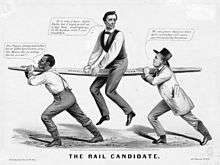
Prior to the Republican convention, the Lincoln campaign began cultivating a nationwide youth organization, the Wide Awakes, which it used to generate popular support throughout the country to spearhead voter registration drives, thinking that new voters and young voters tended to embrace new parties.[55] Lincoln's ideas of abolishing slavery grew, drawing more supporters. People of the Northern states knew the Southern states would vote against Lincoln and rallied supporters for Lincoln.[56]
As Douglas and the other candidates campaigned, Lincoln gave no speeches, relying on the enthusiasm of the Republican Party. The party did the leg work that produced majorities across the North, and produced an abundance of campaign posters, leaflets, and newspaper editorials. Republican speakers focused first on the party platform, and second on Lincoln's life story, emphasizing his childhood poverty. The goal was to demonstrate the power of "free labor", which allowed a common farm boy to work his way to the top by his own efforts.[8]:254–256 The Republican Party's production of campaign literature dwarfed the combined opposition; a Chicago Tribune writer produced a pamphlet that detailed Lincoln's life, and sold 100,000–200,000 copies.[8]:254

On November 6, 1860, Lincoln was elected the 16th president. He was the first Republican president and his victory was entirely due to his support in the North and West; no ballots were cast for him in 10 of the 15 Southern slave states, and he won only two of 996 counties in all the Southern states.[57]:61 Lincoln received 1,866,452 votes, or 39.8% of the total in a four-way race, carrying the free Northern states, as well as California and Oregon.[14]:350 His victory in the electoral college was decisive: Lincoln had 180 votes to 123 for his opponents.[58]:4:312
Presidency
Secession and inauguration
In response to Lincoln's election, secessionists implemented plans to leave the Union before he took office in March 1861.[59]:350 On December 20, 1860, South Carolina took the lead by adopting an ordinance of secession; by February 1, 1861, Florida, Mississippi, Alabama, Georgia, Louisiana, and Texas followed.[8]:267[60]:498 Six of these states declared themselves to be a sovereign nation, the Confederate States of America, and adopted a constitution.[8]:267 The upper South and border states (Delaware, Maryland, Virginia, North Carolina, Tennessee, Kentucky, Missouri, and Arkansas) initially rejected the secessionist appeal.[14]:362 President Buchanan and President-elect Lincoln refused to recognize the Confederacy, declaring secession illegal.[60]:520, 569–570 The Confederacy selected Jefferson Davis as its provisional President on February 9, 1861.[14]:369
Attempts at compromise followed but Lincoln and the Republicans rejected the proposed Crittenden Compromise as contrary to the Party's platform of free-soil in the territories.[14]:360–361 Lincoln said, "I will suffer death before I consent ... to any concession or compromise which looks like buying the privilege to take possession of this government to which we have a constitutional right."[8]:268
Lincoln tacitly supported the Corwin Amendment to the Constitution, which passed Congress and was awaiting ratification by the states when Lincoln took office. That doomed amendment would have protected slavery in states where it already existed.[61]:22[62]:280–281 A few weeks before the war, Lincoln sent a letter to every governor informing them Congress had passed a joint resolution to amend the Constitution.[63]
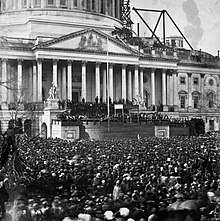
En route to his inauguration, Lincoln addressed crowds and legislatures across the North.[8]:273–277 The president-elect evaded suspected assassins in Baltimore. On February 23, 1861, he arrived in disguise in Washington, D.C., which was placed under substantial military guard.[8]:277–279 Lincoln directed his inaugural address to the South, proclaiming once again that he had no inclination to abolish slavery in the Southern states:
Apprehension seems to exist among the people of the Southern States that by the accession of a Republican Administration their property and their peace and personal security are to be endangered. There has never been any reasonable cause for such apprehension. Indeed, the most ample evidence to the contrary has all the while existed and been open to their inspection. It is found in nearly all the published speeches of him who now addresses you. I do but quote from one of those speeches when I declare that "I have no purpose, directly or indirectly, to interfere with the institution of slavery in the States where it exists. I believe I have no lawful right to do so, and I have no inclination to do so."
Lincoln cited his plans for banning the expansion of slavery as the key source of conflict between North and South, stating "One section of our country believes slavery is right and ought to be extended, while the other believes it is wrong and ought not to be extended. This is the only substantial dispute." The President ended his address with an appeal to the people of the South: "We are not enemies, but friends. We must not be enemies ... The mystic chords of memory, stretching from every battlefield, and patriot grave, to every living heart and hearthstone, all over this broad land, will yet swell the chorus of the Union, when again touched, as surely they will be, by the better angels of our nature."[8]:283–284 The failure of the Peace Conference of 1861 signaled that legislative compromise was impossible. By March 1861, no leaders of the insurrection had proposed rejoining the Union on any terms. Meanwhile, Lincoln and the Republican leadership agreed that the dismantling of the Union could not be tolerated.[8]:268, 279 Later in his second inaugural address Lincoln looked back on the situation at the time and said: "Both parties deprecated war, but one of them would make war rather than let the Nation survive, and the other would accept war rather than let it perish, and the war came."
The Civil War
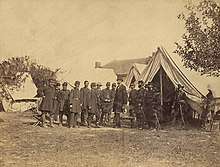
Major Robert Anderson, commander of the Union's Fort Sumter in Charleston, South Carolina, sent a request for provisions to Washington, and Lincoln's order to meet that request was seen by the secessionists as an act of war. On April 12, 1861, Confederate forces fired on Union troops at Fort Sumter and began the fight. Historian Allan Nevins argued that the newly inaugurated Lincoln made three miscalculations: underestimating the gravity of the crisis, exaggerating the strength of Unionist sentiment in the South, and overlooking Southern Unionist opposition to an invasion.[65]:5:29
William Tecumseh Sherman talked to Lincoln during inauguration week and was "sadly disappointed" at his failure to realize that "the country was sleeping on a volcano" and that the South was preparing for war.[66]:185–186 Donald concludes that, "His repeated efforts to avoid collision in the months between inauguration and the firing on Ft. Sumter showed he adhered to his vow not to be the first to shed fraternal blood. But he also vowed not to surrender the forts. The only resolution of these contradictory positions was for the confederates to fire the first shot; they did just that."[8]:293
On April 15, Lincoln called on the states to send detachments totaling 75,000 troops to recapture forts, protect Washington, and "preserve the Union", which, in his view, remained intact despite the seceding states. This call forced states to choose sides. Virginia seceded and was rewarded with the designation of Richmond as the Confederate capital, despite its exposure to Union lines. North Carolina, Tennessee, and Arkansas followed over the following two months. Secession sentiment was strong in Missouri and Maryland, but did not prevail; Kentucky remained neutral.[16]:226 The Fort Sumter attack rallied Americans north of the Mason-Dixon line to defend the nation.
As States sent Union regiments south, on April 19 Baltimore mobs in control of the rail links attacked Union troops who were changing trains. Local leaders' groups later burned critical rail bridges to the capital and the Army responded by arresting local Maryland officials. Lincoln suspended the writ of habeas corpus where needed for the security of troops trying to reach Washington.[67]:174 John Merryman, one Maryland official hindering the U.S. troop movements, petitioned Supreme Court Chief Justice Roger B. Taney to issue a writ of habeas corpus. In June Taney, ruling only for the lower circuit court in ex parte Merryman, issued the writ which he felt could only be suspended by Congress. Lincoln persisted with the policy of suspension in select areas.[68][69]:3–31
Union military strategy
Lincoln took executive control of the war and shaped the Union military strategy. He responded to the unprecedented political and military crisis as commander-in-chief by exercising unprecedented authority. He expanded his war powers, imposed a blockade on Confederate ports, disbursed funds before appropriation by Congress, suspended habeas corpus, and arrested and imprisoned thousands of suspected Confederate sympathizers. Lincoln gained the support of the Congress and the northern public for these actions. Lincoln also had to reinforce Union sympathies in the border slave states and keep the war from becoming an international conflict.[8]:303–304[50]:163–164
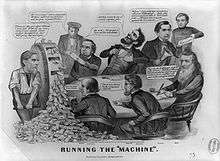
It was clear from the outset that bipartisan support was essential to success, and that any compromise alienated factions on both sides of the aisle, such as the appointment of Republicans and Democrats to command positions. Copperheads criticized Lincoln for refusing to compromise on slavery. The Radical Republicans criticized him for moving too slowly in abolishing slavery.[8]:315–339, 417 On August 6, 1861, Lincoln signed the Confiscation Act that authorized judicial proceedings to confiscate and free slaves who were used to support the Confederates. The law had little practical effect, but it signaled political support for abolishing slavery.[8]:314[50]:178
In August 1861, General John C. Frémont, the 1856 Republican presidential nominee, without consulting Washington, issued a martial edict freeing slaves of the rebels. Lincoln cancelled the illegal proclamation as politically motivated and lacking military necessity.[8]:314–317 As a result, Union enlistments from Maryland, Kentucky, and Missouri increased by over 40,000.[50]:181
Internationally, Lincoln wanted to forestall foreign military aid to the Confederacy.[31]:213–214 He relied on his combative Secretary of State William Seward while working closely with Senate Foreign Relations Committee chairman Charles Sumner.[8]:322 In the 1861 Trent Affair which threatened war with Great Britain, the U.S. Navy illegally intercepted a British mail ship, the Trent, on the high seas and seized two Confederate envoys; Britain protested vehemently while the U.S. cheered. Lincoln ended the crisis by releasing the two diplomats. Biographer James G. Randall dissected Lincoln's successful techniques:[70]
his restraint, his avoidance of any outward expression of truculence, his early softening of State Department's attitude toward Britain, his deference toward Seward and Sumner, his withholding of his paper prepared for the occasion, his readiness to arbitrate, his golden silence in addressing Congress, his shrewdness in recognizing that war must be averted, and his clear perception that a point could be clinched for America's true position at the same time that satisfaction was given to a friendly country.
Lincoln painstakingly monitored the telegraph reports coming into the War Department. He tracked all phases of the effort, consulting with governors, and selecting generals based on their success, their state, and their party. In January 1862, after complaints of inefficiency and profiteering in the War Department, Lincoln replaced War Secretary Simon Cameron with Edwin Stanton. Stanton centralized the War Department's activities, auditing and canceling contracts, saving the federal government $17,000,000.[32]:115 Stanton was a staunch Unionist, pro-business, conservative Democrat who gravitated toward the Radical Republican faction. He worked more often and more closely with Lincoln than any other senior official. "Stanton and Lincoln virtually conducted the war together," say Thomas and Hyman.[71]
Lincoln's war strategy embraced two priorities: ensuring that Washington was well-defended and conducting an aggressive war effort for a prompt, decisive victory. [lower-alpha 7] Twice a week, Lincoln met with his cabinet in the afternoon. Occasionally Mary prevailed on him to take a carriage ride, concerned that he was working too hard.[8]:391–392 For his edification Lincoln relied upon a book by his chief of staff General Henry Halleck entitled Elements of Military Art and Science; Halleck was a disciple of the European strategist Antoine-Henri Jomini. Lincoln began to appreciate the critical need to control strategic points, such as the Mississippi River.[72]:7, 66, 159 Lincoln saw the importance of Vicksburg and understood the necessity of defeating the enemy's army, rather than simply capturing territory.[8]:432–436
General McClellan
After the Union rout at Bull Run and Winfield Scott's retirement, Lincoln appointed Major General George B. McClellan general-in-chief.[8]:318–319 McClellan then took months to plan his Virginia Peninsula Campaign. McClellan's slow progress frustrated Lincoln, as did his position that no troops were needed to defend Washington. McClellan, in turn, blamed the failure of the campaign on Lincoln's reservation of troops for the capitol.[8]:349–352
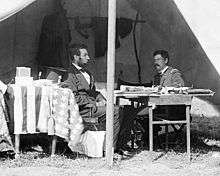
In 1862 Lincoln removed McClellan for the general's continued inaction; He elevated Henry Halleck in July and appointed John Pope as head of the new Army of Virginia.[73] Pope satisfied Lincoln's desire to advance on Richmond from the north, thus protecting Washington from counterattack.[58]:2:159–162 But Pope was then soundly defeated at the Second Battle of Bull Run in the summer of 1862, forcing the Army of the Potomac back to defend Washington.[74]:2:159–162
Despite his dissatisfaction with McClellan's failure to reinforce Pope, Lincoln restored him to command of all forces around Washington.[75]:478–479 Two days after McClellan's return to command, General Robert E. Lee's forces crossed the Potomac River into Maryland, leading to the Battle of Antietam.[75]:478–480 That battle, a Union victory, was among the bloodiest in American history; it facilitated Lincoln's Emancipation Proclamation in January.[75]:481
McClellan then resisted the president's demand that he pursue Lee's withdrawing army, while General Don Carlos Buell likewise refused orders to move the Army of the Ohio against rebel forces in eastern Tennessee. Lincoln replaced Buell with William Rosecrans; and after the 1862 midterm elections he replaced McClellan with Ambrose Burnside. The appointments were both politically neutral and adroit on Lincoln's part.[8]:389–390
Burnside, against presidential advice, launched an offensive across the Rappahannock River and was defeated by Lee at Fredericksburg in December. Desertions during 1863 came in the thousands and only increased after Fredericksburg, so Lincoln replaced Burnside with Joseph Hooker.[58]:6:433–44[8]:429–431
In the 1862 midterm elections the Republicans suffered severe losses due to rising inflation, high taxes, rumors of corruption, suspension of habeas corpus, military draft law, and fears that freed slaves would come North and undermine the labor market. The Emancipation Proclamation gained votes for Republicans in rural New England and the upper Midwest, but cost votes in the Irish and German strongholds and in the lower Midwest, where many Southerners had lived for generations.[58]:6:322 years
In the spring of 1863 Lincoln was sufficiently optimistic about upcoming military campaigns to think the end of the war could be near; the plans included attacks by Hooker on Lee north of Richmond, Rosecrans on Chattanooga, Grant on Vicksburg, and a naval assault on Charleston.[8]:422–423
Hooker was routed by Lee at the Battle of Chancellorsville in May, then resigned and was replaced by George Meade.[58]:6:432–450 Meade followed Lee north into Pennsylvania and beat him in the Gettysburg Campaign, but then failed to follow up despite Lincoln's demands. At the same time, Grant captured Vicksburg and gained control of the Mississippi River, splitting the far western rebel states.[8]:444–447
Emancipation Proclamation

The Federal government's power to end slavery was limited by the Constitution, which before 1865 delegated the issue to the individual states. Lincoln argued that slavery would be rendered obsolete if its expansion into new territories were prevented. He sought to persuade the states to agree to compensation for emancipating their slaves in return for their acceptance of abolition.[76] Lincoln rejected Fremont's two emancipation attempts in August 1861, as well as one by Major General David Hunter in May 1862, on the grounds that it was not within their power, and would upset loyal border states.[77]:290–291
In June of 1862, Congress passed an act banning slavery on all federal territory, which Lincoln signed. In July, the Confiscation Act of 1862 was enacted, providing court procedures to free the slaves of those convicted of aiding the rebellion; Lincoln approved the bill despite his belief that it was unconstitutional. He felt such action could be taken only within the war powers of the Commander-in-Chief, which he planned to exercise. Lincoln at this time reviewed a draft of the Emancipation Proclamation with his cabinet.[8]:364–365
Privately, Lincoln concluded that the Confederacy's slave base had to be eliminated. Copperheads argued that emancipation was a stumbling block to peace and reunification; Republican editor Horace Greeley of the New York Tribune agreed.[78]:124 In a letter of August 22, 1862, Lincoln said that while he personally wished all men could be free, regardless of that, his first obligation as president was to preserve the Union:[79]:147–153
My paramount object in this struggle is to save the Union, and is not either to save or to destroy slavery. If I could save the Union without freeing any slave I would do it, and if I could save it by freeing all the slaves I would do it; and if I could save it by freeing some and leaving others alone I would also do that. What I do about slavery, and the colored race, I do because I believe it helps to save the Union; and what I forbear, I forbear because I do not believe it would help to save the Union ... [¶] I have here stated my purpose according to my view of official duty; and I intend no modification of my oft-expressed personal wish that all men everywhere could be free.[37]:388
The Emancipation Proclamation, issued on September 22, 1862 and effective January 1, 1863, affirmed the freedom of slaves in 10 states not then under Union control, with exemptions specified for areas under such control.[8]:364, 379 Lincoln's comment on signing the Proclamation was: "I never, in my life, felt more certain that I was doing right, than I do in signing this paper."[8]:407 He spent the next 100 days preparing the army and the nation for emancipation, while Democrats rallied their voters by warning of the threat that freed slaves posed to northern whites.[80]
With the abolition of slavery in the rebel states now a military objective, Union armies advancing south liberated three million slaves.
Enlisting former slaves became official policy. By the spring of 1863, Lincoln was ready to recruit black troops in more than token numbers. In a letter to Tennessee military governor Andrew Johnson encouraging him to lead the way in raising black troops, Lincoln wrote, "The bare sight of 50,000 armed and drilled black soldiers on the banks of the Mississippi would end the rebellion at once".[8]:430–431 By the end of 1863, at Lincoln's direction, General Lorenzo Thomas had recruited 20 regiments of blacks from the Mississippi Valley.[8]:431
The Proclamation included Lincoln’s earlier plans for colonies for newly freed slaves, though that undertaking ultimately failed.[8]:408
Gettysburg Address (1863)
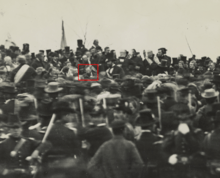
Lincoln spoke at the dedication of the Gettysburg battlefield cemetery on November 19, 1863.[8]:453–460 In 272 words, and three minutes, Lincoln asserted that the nation was born not in 1789, but in 1776, "conceived in Liberty, and dedicated to the proposition that all men are created equal". He defined the war as dedicated to the principles of liberty and equality for all. He declared that the deaths of so many brave soldiers would not be in vain, that slavery would end, and the future of democracy would be assured, that "government of the people, by the people, for the people, shall not perish from the earth".[8]:460–466[81]:20, 27, 105, 146
Defying his prediction that "the world will little note, nor long remember what we say here", the Address became the most quoted speech in American history.[82]:222
General Grant
Grant's victories at the Battle of Shiloh and in the Vicksburg campaign impressed Lincoln. Responding to criticism of Grant after Shiloh, Lincoln had said, "I can't spare this man. He fights."[17]:315 With Grant in command, Lincoln felt the Union Army could advance in multiple theaters, and incorporate black troops. Meade's failure to capture Lee's army after Gettysburg and the continued passivity of the Army of the Potomac persuaded Lincoln to promote Grant to supreme commander. Grant stayed with Meade's army and told Meade what to do.[58]:4:6–17
Lincoln was concerned that Grant might be considering a presidential candidacy in 1864, as was McClellan. Lincoln arranged for an intermediary to inquire into Grant's political intentions. Assured that he had none, Lincoln submitted Grant's appointment to the Senate. He obtained Congress's consent to make him Lieutenant General, a rank that had remained unoccupied since George Washington.[8]:490–492
Grant waged his bloody Overland Campaign in 1864, with heavy losses on both sides.[83]:113 Despite this, when Lincoln asked what Grant's plans were, the general replied, "I propose to fight it out on this line if it takes all summer."[8]:501
Grant's army moved steadily south. Lincoln traveled to Grant's headquarters at City Point, Virginia to confer with Grant and William Tecumseh Sherman.[84] Lincoln reacted to Union losses by mobilizing support throughout the North.[17]:422–424
Lincoln authorized Grant to target infrastructure—plantations, railroads, and bridges—hoping to destroy the South's morale and weaken its fighting ability. Lincoln emphasized defeat of the Confederate armies rather than destruction (which was considerable) for its own sake.[85]:434–458
In 1864 Confederate general Jubal Early raided Washington, D.C., while Lincoln watched from an exposed position; Captain Oliver Wendell Holmes shouted at him, "Get down, you damn fool, before you get shot!"[17]:434
As Grant continued to weaken Lee's forces, efforts to discuss peace began. Confederate Vice President Stephens led a group to meet with Lincoln, Seward, and others at Hampton Roads. Lincoln refused to allow any negotiation with the Confederacy as a coequal; his sole objective was an agreement to end the fighting and the meetings produced no results.[8]:565 On April 1, 1865, Grant nearly encircled Petersburg. The Confederate government evacuated and the city fell. Lincoln visited the conquered capital. On April 9, Lee surrendered to Grant at Appomattox, officially ending the war.[8]:589
Re-election
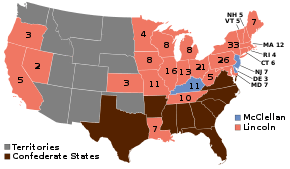
Lincoln ran again in 1864. He united the main Republican factions, along with War Democrats such as Edwin M. Stanton and Andrew Johnson. Lincoln used conversation and his patronage powers—greatly expanded from peacetime—to build support and fend off the Radicals' efforts to replace him.[86]:53–69[87]:77–90 At its convention, the Republicans selected Johnson as his running mate. To broaden his coalition to include War Democrats as well as Republicans, Lincoln ran under the label of the new Union Party.[8]:494–507
Grant's bloody stalemates damaged Lincoln's re-election prospects, and many Republicans feared defeat. Lincoln confidentially pledged in writing that if he should lose the election, he would still defeat the Confederacy before turning over the White House:[88]:80 Lincoln did not show the pledge to his cabinet, but asked them to sign the sealed envelope.
While the Democratic platform followed the "Peace wing" of the party and called the war a "failure", their candidate, McClellan, supported the war and repudiated the platform. Lincoln provided Grant with more troops and led his party to renew its support for Grant. Sherman's capture of Atlanta in September and David Farragut's capture of Mobile ended defeatism.[8]:531 The Democratic Party was deeply split, with some leaders and most soldiers openly for Lincoln. The National Union Party was united by Lincoln's support for emancipation. State Republican parties stressed the perfidy of the Copperheads.[89]:307 On November 8, Lincoln carried all but three states, including 78 percent of Union soldiers.[88]:80[90]:274–293
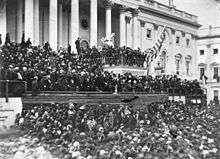
On March 4, 1865, Lincoln delivered his second inaugural address. In it, he deemed the endless casualties to be God's will. Historian Mark Noll claims this speech to rank "among the small handful of semi-sacred texts by which Americans conceive their place in the world".[91]:426 Lincoln said:
Fondly do we hope—fervently do we pray—that this mighty scourge of war may speedily pass away. Yet, if God wills that it continue, until all the wealth piled by the bond-man's 250 years of unrequited toil shall be sunk, and until every drop of blood drawn with the lash, shall be paid by another drawn with the sword, as was said 3,000 years ago, so still it must be said, "the judgments of the Lord, are true and righteous altogether". With malice toward none; with charity for all; with firmness in the right, as God gives us to see the right, let us strive on to finish the work we are in; to bind up the nation's wounds; to care for him who shall have borne the battle, and for his widow, and his orphan—to do all which may achieve and cherish a just and lasting peace, among ourselves, and with all nations.[92]
Reconstruction
Reconstruction began during the war, as Lincoln and his associates considered how to reintegrate the nation, and the fates of Confederate leaders and freed slaves. Shortly after Lee's surrender, a general asked Lincoln how to treat defeated Confederates. Lincoln replied, "Let 'em up easy."[17]:509–512 Lincoln was determined to find meaning in the war even when it had passed, and did not want to continue to outcast the southern states. His main goal was to keep the union together. He planned to go forward not by focusing on whom to blame, but on how to rebuild the nation as one.[93] Lincoln led the moderates regarding Reconstruction policy, and was opposed by the Radicals, under Rep. Thaddeus Stevens, Sen. Charles Sumner and Sen. Benjamin Wade, who otherwise remained Lincoln's allies. Determined to reunite the nation and not alienate the South, Lincoln urged that speedy elections under generous terms be held. His Amnesty Proclamation of December 8, 1863, offered pardons to those who had not held a Confederate civil office, had not mistreated Union prisoners, and would sign an oath of allegiance.[8]:471–472

As Southern states fell, they needed leaders while their administrations re-formed. In Tennessee and Arkansas, Lincoln appointed Johnson and Frederick Steele as military governors, respectively. In Louisiana, Lincoln ordered General Nathaniel P. Banks to promote a plan that would restore statehood when 10 percent of the voters agreed. Democratic opponents accused Lincoln of using the military to ensure his and the Republicans' political aspirations. The Radicals denounced his policy as too lenient, and passed their own plan, the Wade–Davis Bill, in 1864, which Lincoln vetoed. The Radicals retaliated by refusing to seat elected representatives from Louisiana, Arkansas, and Tennessee.[8]:485–486
Lincoln's appointments were designed to harness both moderates and Radicals. To fill Chief Justice Taney's seat on the Supreme Court, he named the Radicals' choice, Salmon P. Chase, who Lincoln believed would uphold his emancipation and paper money policies.[58]:4:206
After implementing the Emancipation Proclamation, Lincoln increased pressure on Congress to outlaw slavery throughout the nation with a constitutional amendment. He declared that such an amendment would "clinch the whole matter".[8]:561 By December 1863, an amendment was brought to Congress. This first attempt failed, falling short of the required two-thirds majority on June 15, 1864, in the House of Representatives. Passage became part of the Republican/Unionist platform. After a House debate, the second attempt passed on January 31, 1865.[8]:562–563[94] With ratification, it became the Thirteenth Amendment to the United States Constitution on December 6, 1865.[95]
Lincoln believed the federal government had limited responsibility to the millions of freedmen. He signed Senator Charles Sumner's Freedmen's Bureau bill that set up a temporary federal agency designed to meet the immediate needs of former slaves. The law opened land for a lease of three years with the ability to purchase title for the freedmen. Lincoln announced a Reconstruction plan that involved short-term military control, pending readmission under the control of southern Unionists.[50]:242–243
Historians agree that it is impossible to predict exactly how Reconstruction would have proceeded had Lincoln lived. Biographers James G. Randall and Richard Current, according to David Lincove, argue that:[96]
It is likely that had he lived, Lincoln would have followed a policy similar to Johnson's, that he would have clashed with congressional Radicals, that he would have produced a better result for the freedmen than occurred, and that his political skills would have helped him avoid Johnson's mistakes.
Eric Foner argues that:[97]
Unlike Sumner and other Radicals, Lincoln did not see Reconstruction as an opportunity for a sweeping political and social revolution beyond emancipation. He had long made clear his opposition to the confiscation and redistribution of land. He believed, as most Republicans did in April 1865, that the voting requirements should be determined by the states. He assumed that political control in the South would pass to white Unionists, reluctant secessionists, and forward-looking former Confederates. But time and again during the war, Lincoln, after initial opposition, had come to embrace positions first advanced by abolitionists and Radical Republicans. ... Lincoln undoubtedly would have listened carefully to the outcry for further protection for the former slaves ... It is entirely plausible to imagine Lincoln and Congress agreeing on a Reconstruction policy that encompassed federal protection for basic civil rights plus limited black suffrage, along the lines Lincoln proposed just before his death.
Native American policy
Lincoln's connection with Indians was pre-dated by his grandfather, who was killed by Indians in 1784. Lincoln claimed Indians were antagonistic toward his father, Thomas Lincoln, and his young family. Although Lincoln was a veteran of the Black Hawk War, fought in Wisconsin and Illinois, in 1832, he saw no significant action.[98]:3 During his presidency, Lincoln's policy toward Indians was dominated by political considerations.[98]:3 Lincoln used the Indian Bureau as a source of patronage, making blanket appointments to his loyal followers in Minnesota and Wisconsin.[98]:4 President Lincoln faced difficulties guarding Western settlers, railroads, and telegraphs, from Indian attacks.[98]:4
On August 17, 1862, the Sioux Uprising, in alliance with the Yankton Indians, started in Minnesota, killing hundreds of white settlers and forcing 30,000 from their homes.[99]:480 The Indian violence deeply alarmed the Lincoln administration. Some believed it was a conspiracy by the Confederacy to launch a war on the Northwestern front.[98]:4–5,7 Taking the matter seriously, Lincoln sent a senior general, John Pope, to Minnesota, making him commander of the new Northwestern Department.[98]:7 Lincoln ordered thousands of Confederate prisoners of war (POWs), sent by railroad, to put down the Sioux Uprising.[99]:481[98]:7 When the Confederates protested turning POWs into Indian fighters, Lincoln relented, and revoked the policy.[99]:481 Pope campaigned against the Indians mercilessly and with vigor, even advocating their extinction. Pope ordered Indian farms and food supplies to be destroyed, and Indian warriors to be killed.[98]:7 Aiding Pope, Minnesota Congressman Col. Henry H. Sibley led militiamen and regular troops to defeat the Sioux at Wood Lake.[99]:481 By October 9, Pope considered the uprising to be ended, although hostilities ceased on December 26.[98]:8
Presented with 303 execution warrants for Santee Dakota who were convicted of killing innocent farmers, Lincoln conducted his own personal review of each warrant, eventually approving 39 for execution (one was later reprieved).[100]:182 Former Governor of Minnesota Alexander Ramsey told Lincoln, in 1864, that Lincoln would have gotten more presidential election support had he executed all 303 of the Indians. Lincoln responded, "I could not afford to hang men for votes."[99]:483
Other enactments
Lincoln adhered to the Whig theory of the presidency, giving Congress primary responsibility for lawmaking while the Executive enforced them. Lincoln vetoed only four bills; the only important one was the Wade-Davis Bill with its harsh Reconstruction program.[101]:137 The 1862 Homestead Act made millions of acres of Western government-held land available for purchase at low cost. The 1862 Morrill Land-Grant Colleges Act provided government grants for agricultural colleges in each state. The Pacific Railway Acts of 1862 and 1864 granted federal support for the construction of the United States' First Transcontinental Railroad, which was completed in 1869.[90]:116 The passage of the Homestead Act and the Pacific Railway Acts was enabled by the absence of Southern congressmen and senators who had opposed the measures in the 1850s.[102]:450–452
In July 1861, the US issued paper currency for the first time. The currency became known greenbacks, because it was printed in green on the reverse side.[103]
| The Lincoln Cabinet[104] | ||
|---|---|---|
| Office | Name | Term |
| President | Abraham Lincoln | 1861–1865 |
| Vice President | Hannibal Hamlin | 1861–1865 |
| Andrew Johnson | 1865 | |
| Secretary of State | William H. Seward | 1861–1865 |
| Secretary of Treasury | Salmon P. Chase | 1861–1864 |
| William P. Fessenden | 1864–1865 | |
| Hugh McCulloch | 1865 | |
| Secretary of War | Simon Cameron | 1861–1862 |
| Edwin M. Stanton | 1862–1865 | |
| Attorney General | Edward Bates | 1861–1864 |
| James Speed | 1864–1865 | |
| Postmaster General | Montgomery Blair | 1861–1864 |
| William Dennison Jr. | 1864–1865 | |
| Secretary of the Navy | Gideon Welles | 1861–1865 |
| Secretary of the Interior | Caleb Blood Smith | 1861–1862 |
| John Palmer Usher | 1863–1865 | |
Other important legislation involved two measures to raise revenues for the Federal government: tariffs (a policy with long precedent), and a Federal income tax. In 1861, Lincoln signed the second and third Morrill Tariffs, following the first enacted by Buchanan. Also in 1861, Lincoln signed the Revenue Act of 1861, creating the first U.S. income tax.[8]:424 This created a flat tax of 3 percent on incomes above $800 ($22,800 in current dollar terms). The Revenue Act of 1862 adopted rates that increased with income.[90]:111
Lincoln presided over the expansion of the federal government's economic influence in other areas. The National Banking Act created the system of national banks. It also established a national currency. In 1862, Congress created the Department of Agriculture.[101]:424
In response to rumors of a renewed draft, the editors of the New York World and the Journal of Commerce published a false draft proclamation that created an opportunity for the editors and others employed at the publications to corner the gold market. Lincoln attacked the media about such behavior, ordering the military to seize the two papers. The seizure lasted for two days.[8]:501–502
Lincoln is largely responsible for the Thanksgiving holiday.[8]:471 Thanksgiving had become a regional holiday in New England in the 17th century. It had been sporadically proclaimed by the federal government on irregular dates. The prior proclamation had been during James Madison's presidency 50 years earlier. In 1863, Lincoln declared the final Thursday in November of that year to be a day of Thanksgiving.[8]:471
In June 1864, Lincoln approved the Yosemite Grant enacted by Congress, which provided unprecedented federal protection for the area now known as Yosemite National Park.[105]
Judicial appointments
.jpg)
Supreme Court appointments
| Justice | Nominated | Appointed |
|---|---|---|
| Noah Haynes Swayne | January 21, 1862 | January 24, 1862 |
| Samuel Freeman Miller | July 16, 1862 | July 16, 1862 |
| David Davis | December 1, 1862 | December 8, 1862 |
| Stephen Johnson Field | March 6, 1863 | March 10, 1863 |
| Salmon Portland Chase (Chief Justice) | December 6, 1864 | December 6, 1864 |
Lincoln's declared philosophy on court nominations was that "we cannot ask a man what he will do, and if we should, and he should answer us, we should despise him for it. Therefore we must take a man whose opinions are known."[8]:471 Lincoln made five appointments to the United States Supreme Court. Noah Haynes Swayne was chosen as an anti-slavery lawyer who was committed to the Union. Samuel Freeman Miller, supported Lincoln in the 1860 election and was an avowed abolitionist. David Davis was Lincoln's campaign manager in 1860 and had served as a judge in Lincoln's Illinois court circuit. Democrat Stephen Johnson Field, a previous California Supreme Court justice, provided geographic and political balance. Finally, Lincoln's Treasury Secretary, Salmon P. Chase, became Chief Justice. Lincoln believed Chase was an able jurist, would support Reconstruction legislation, and that his appointment united the Republican Party.[106]:245
Other judicial appointments
Lincoln appointed 32 federal judges, including four Associate Justices and one Chief Justice to the Supreme Court of the United States, and 27 judges to the United States district courts. Lincoln appointed no judges to the United States circuit courts during his time in office.[107][108]
States admitted to the Union
West Virginia was admitted to the Union on June 20, 1863. Nevada, which became the third State in the far-west of the continent, was admitted as a free state on October 31, 1864.[8]:300, 539
Assassination
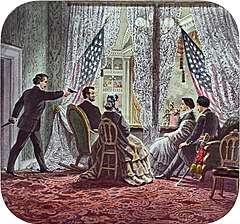
Abraham Lincoln was assassinated by John Wilkes Booth on Good Friday, April 14, 1865, while attending a play at Ford's Theatre with his wife, a mere five days after Lee's surrender. Booth was a well-known actor and a Confederate spy from Maryland; though he never joined the Confederate army, he had contacts with the Confederate secret service.[8]:586–587 After attending an April 11, 1865, speech in which Lincoln promoted voting rights for blacks, Booth decided to assassinate the President.[109]:3–4 Learning of Lincoln's intent to attend the play with Grant, Booth and his co-conspirators planned to assassinate Lincoln and Grant at the theater and to kill Vice President Johnson and Secretary of State Seward at their respective homes. Lincoln left to attend the play Our American Cousin on April 14. At the last minute, Grant decided to go to New Jersey to visit his children instead of attending the play.[8]:594–597
At 10:14 pm, Booth entered the back of Lincoln's theater box, crept up from behind, and fired at the back of Lincoln's head, mortally wounding him. Lincoln's guest Major Henry Rathbone momentarily grappled with Booth, but Booth stabbed him and escaped.[8]:597[110] Lincoln was taken across the street to Petersen House. After remaining in a coma for eight hours, Lincoln died at 7:22 am on April 15.[24]:153[lower-alpha 8] Stanton saluted and said, "Now he belongs to the ages."[8]:598–599, 686[lower-alpha 9] Lincoln's flag-enfolded body was then escorted in the rain to the White House by bareheaded Union officers, while the city's church bells rang. President Johnson was sworn in at 10:00 am.
Two weeks later, Booth was tracked to a farm in Virginia. Refusing to surrender, Sergeant Boston Corbett killed Booth on April 26.[24]:153[8]:599
Funeral and burial
The late President lay in state, first in the East Room, and then in the Capitol Rotunda from April 19 through April 21. The caskets containing Lincoln's body and the body of his son Willie traveled for three weeks on the Lincoln Special funeral train.[115] The train followed a circuitous route from Washington D.C. to Springfield, Illinois, stopping at many cities for memorials attended by hundreds of thousands. Many others gathered along the tracks as the train passed with bands, bonfires, and hymn singing[115]:31–58[116]:231–238 or in silent grief. Poet Walt Whitman composed When Lilacs Last in the Dooryard Bloom'd to eulogize him, one of four poems he wrote about Lincoln.[117] African-Americans were especially moved; they had lost 'their Moses'.[118]:164 In a larger sense, the reaction was in response to the deaths of so many men in the war.[118]:197–199 Historians emphasized the widespread shock and sorrow, but noted that some Lincoln haters celebrated his death.[118](pp84, 86, 96–97)
Religious and philosophical beliefs
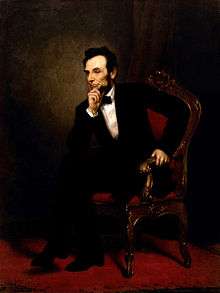
As a young man, Lincoln was a religious skeptic.[50]:4[119]:84 He was deeply familiar with the Bible, and both quoted and praised it.[8]:48–49, 514–515 He was private about his beliefs as to organized religion and respected the beliefs of others.[120] Lincoln never made a clear profession of Christian beliefs.[121] Through his entire public career, Lincoln had a proneness for quoting Scripture.[122] His three most famous speeches -- the House Divided Speech, the Gettysburg Address, and his second inaugural—each contain direct allusions to Providence and quotes from Scripture.
In the 1840s, Lincoln subscribed to the Doctrine of Necessity, a belief that asserted the human mind was controlled by some higher power.[8]:48–49 With the death of his son Edward (died 1850), Lincoln more frequently expressed a need to depend on God.[123]:227–253 He never joined a church, although he frequently attended First Presbyterian Church with his wife beginning in 1852.[124][lower-alpha 10] He rented a pew and occasionally attended church services.[124]
In the 1850s, Lincoln asserted his belief in "providence" in a general way, and rarely used the language or imagery of the evangelicals; he regarded the republicanism of the Founding Fathers with an almost religious reverence.[125] The death of son Willie in February 1862 may have caused Lincoln to look toward religion for solace.[119]:251–254 After Willie's death, Lincoln considered why, from a divine standpoint, the severity of the war was necessary. He wrote at this time that God "could have either saved or destroyed the Union without a human contest. Yet the contest began. And having begun, He could give the final victory to either side any day. Yet the contest proceeds."[119]:254
He did believe in an all-powerful God that shaped events and by 1865 was expressing those beliefs in major speeches.[121] By the end of the war, Lincoln increasingly appealed to the Almighty for solace and to explain events, writing in April 4, 1864 to a newspaper editor in Kentucky:
I claim not to have controlled events, but confess plainly that events have controlled me. Now, at the end of three years struggle the nation's condition is not what either party, or any man devised, or expected. God alone can claim it. Whither it is tending seems plain. If God now wills the removal of a great wrong, and wills also that we of the North as well as you of the South, shall pay fairly for our complicity in that wrong, impartial history will find therein new cause to attest and revere the justice and goodness of God.[126]
This deep spirituality can perhaps best be seen in his Second Inaugural Address, considered by some scholars[127] and Lincoln himself (he wrote to Thurlow Weed on March 4, 1865, "I except [my Second Inaugural] to wear as well as--perhaps better than--any thing I have ever produced") as the greatest such address in American history,[128] in which Lincoln explains the cause, purpose, and result of the war was God's will.[129] Later in life, Lincoln's frequent use of religious imagery and language might have reflected his own personal beliefs or might have been a device to reach his audiences, who were mostly evangelical Protestants.[130]:27–55 On the day Lincoln was assassinated, he reportedly told his wife he desired to visit the Holy Land.[77]:434
Health
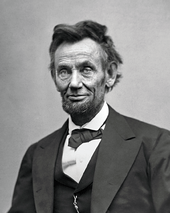
Lincoln is believed to have had depression, smallpox, and malaria.[131] He took blue mass pills, which contained mercury, to treat constipation.[132] It is unknown to what extent he may have suffered from mercury poisoning.[133]
Several claims have been made that Lincoln's health was declining before the assassination. These are often based on photographs of Lincoln appearing to show weight loss and muscle wasting.[134] It is also suspected that he might have had a rare genetic disease such as Marfan syndrome or Multiple endocrine neoplasia type 2B.[134]
Legacy
Republican values
Lincoln's redefinition of republican values have been stressed by historians such as John Patrick Diggins, Harry V. Jaffa, Vernon Burton, Eric Foner, and Herman J. Belz.[135] Lincoln called the Declaration of Independence—which emphasized freedom for all and equality—the "sheet anchor" of republicanism beginning in the 1850s. He did this at a time when the Constitution, which "tolerated slavery", was the focus of most political discourse.[49]:399[135] Diggins notes, "Lincoln presented Americans a theory of history that offers a profound contribution to the theory and destiny of republicanism itself" in the 1860 Cooper Union speech.[136]:307[135] Instead of focusing on the legality of an argument, he focused on the moral basis of republicanism.[30]:215[135]
His position on war, though, was founded on a legal argument regarding the Constitution. His position was in effect that the Constitution is essentially a contract among the states, and all parties must agree to pull out of the contract. Further, it was a national duty to ensure the republic stands in every state.[49]:263[135] Many soldiers and religious leaders from the north, though, felt the fight for liberty and freedom of slaves was ordained by their moral and religious beliefs.[137]
As a Whig activist, Lincoln was a spokesman for business interests, favoring high tariffs, banks, infrastructure improvements, and railroads, in opposition to Jacksonian democrats.[31]:196–198, 229–231, 301 William C. Harris found that Lincoln's "reverence for the Founding Fathers, the Constitution, the laws under it, and the preservation of the Republic and its institutions strengthened his conservatism".[33]:2 James G. Randall emphasizes his tolerance and moderation "in his preference for orderly progress, his distrust of dangerous agitation, and his reluctance toward ill digested schemes of reform". Randall concludes that, "he was conservative in his complete avoidance of that type of so-called 'radicalism' which involved abuse of the South, hatred for the slaveholder, thirst for vengeance, partisan plotting, and ungenerous demands that Southern institutions be transformed overnight by outsiders."[5]:175
Reunification of the states
In Lincoln's first inaugural address, he explored the nature of democracy. He denounced secession as anarchy, and explained that majority rule had to be balanced by constitutional restraints. He said "A majority held in restraint by constitutional checks and limitations, and always changing easily with deliberate changes of popular opinions and sentiments, is the only true sovereign of a free people."[138]:86
The successful reunification of the states had consequences for how people view the country. The term "the United States" has historically been used, sometimes in the plural ("these United States"), and other times in the singular. The Civil War was a significant force in the eventual dominance of the singular usage by the end of the 19th century.[139]
Historical reputation
In his company, I was never reminded of my humble origin, or of my unpopular color.
In surveys of U.S. scholars ranking presidents conducted since 1948, the top three presidents are Lincoln, Washington, and Franklin Delano Roosevelt, although the order varies.[6][lower-alpha 11] Between 1999 and 2011, Lincoln, John F. Kennedy, and Ronald Reagan have been the top-ranked presidents in eight surveys, according to Gallup.[7] A 2004 study found that scholars in the fields of history and politics ranked Lincoln number one, while legal scholars placed him second after George Washington.[142]:264
President Lincoln's assassination left him a national martyr. He was viewed by abolitionists as a champion of human liberty. Republicans linked Lincoln's name to their party. Many, though not all, in the South considered Lincoln as a man of outstanding ability.[143]:76, 79, 106, 110 Historians have said he was "a classical liberal" in the 19th-century sense. Allen C. Guelzo states that Lincoln was a "classical liberal democrat—an enemy of artificial hierarchy, a friend to trade and business as ennobling and enabling, and an American counterpart to Mill, Cobden, and Bright" (whose portrait Lincoln hung in his White House office).[144][5]
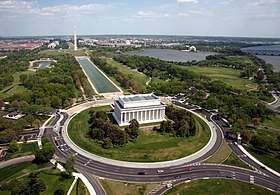
Schwartz argues that Lincoln's American reputation grew slowly from the late 19th century until the Progressive Era (1900–1920s) when he emerged as one of America's most venerated heroes, even among white Southerners. The high point came in 1922 with the dedication of the Lincoln Memorial on the National Mall in Washington, D.C.[145]:109
Union nationalism, as envisioned by Lincoln, "helped lead America to the nationalism of Theodore Roosevelt, Woodrow Wilson, and Franklin Delano Roosevelt."[31]:222 In the New Deal era, liberals honored Lincoln not so much as the self-made man or the great war president, but as the advocate of the common man who they claimed would have supported the welfare state.[146]:23, 91–98
Sociologist Barry Schwartz argues that in the 1930s and 1940s, the memory of Abraham Lincoln was practically sacred and provided the nation with "a moral symbol inspiring and guiding American life". During the Great Depression, he argues, Lincoln served "as a means for seeing the world's disappointments, for making its sufferings not so much explicable as meaningful". Franklin D. Roosevelt, preparing America for war, used the words of the Civil War president to clarify the threat posed by Germany and Japan. Americans asked, "What would Lincoln do?"[146]:xi, 9, 24 However, Schwartz also finds that since World War II, Lincoln's symbolic power has lost relevance, and this "fading hero is symptomatic of fading confidence in national greatness". He suggested that postmodernism and multiculturalism have diluted greatness as a concept.[146]:xi, 9
In the Cold War years, Lincoln's image shifted to a symbol of freedom who brought hope to those oppressed by Communist regimes.[146]:23, 91–98 By the late 1960s, some African American intellectuals, led by Lerone Bennett Jr., rejected Lincoln's role as the Great Emancipator.[147][148] Bennett won wide attention when he called Lincoln a white supremacist in 1968.[149]:35–42 He noted that Lincoln used ethnic slurs and told jokes that ridiculed blacks. Bennett argued that Lincoln opposed social equality, and proposed sending freed slaves to another country. Defenders, such as authors Dirck and Cashin, retorted that he was not as bad as most politicians of his day;[150]:31 and that he was a "moral visionary" who deftly advanced the abolitionist cause, as fast as politically possible.[151]:2–4 The emphasis shifted away from Lincoln the emancipator to an argument that blacks had freed themselves from slavery, or at least were responsible for pressuring the government on emancipation.[152]:61[153]:228
By the 1970s, Lincoln had become a hero to political conservatives[154] for his intense nationalism, support for business, his insistence on stopping the spread of human bondage, his acting in terms of Lockean and Burkean principles on behalf of both liberty and tradition, and his devotion to the principles of the Founding Fathers.[155]:514–518[156]:67–94[157]:43–45 Lincoln became a favorite exemplar for liberal intellectuals across the world.[158]
Historian Barry Schwartz wrote in 2009 that Lincoln's image suffered "erosion, fading prestige, benign ridicule" in the late 20th century.[146]:146 On the other hand, Donald opined in his 1996 biography that Lincoln was distinctly endowed with the personality trait of negative capability, defined by the poet John Keats and attributed to extraordinary leaders who were "content in the midst of uncertainties and doubts, and not compelled toward fact or reason".[8]:15
In the 21st century, President Barack Obama named Lincoln his favorite president and insisted on using Lincoln's Bible for his inaugural ceremonies.[159][160][161] Lincoln has often been portrayed by Hollywood, almost always in a flattering light.[162][163]
Memory and memorials
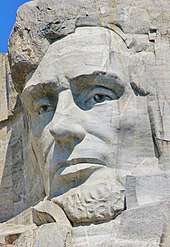
Lincoln's portrait appears on two denominations of United States currency, the penny and the $5 bill. His likeness also appears on many postage stamps.[164] While he is usually portrayed bearded, he grew a beard in 1860 at the suggestion of 11-year-old Grace Bedell. He was the first of 16 presidents to do so.[165]
He has been memorialized in many town, city, and county names,[166]:194 including the capital of Nebraska.[166]:197 The United States Navy Nimitz-class aircraft carrier USS Abraham Lincoln (CVN-72) is named after Lincoln, the second Navy ship to bear his name.[167]
Lincoln Memorial is one of the most visited monuments in the nation's capital,[168] and is one of the top five visited National Park Service sites in the country.[169] Ford's Theatre, among the top sites in Washington, D.C.,[169] is across the street from Petersen House (where he died).[170] Memorials in Springfield, Illinois include Abraham Lincoln Presidential Library and Museum, Lincoln's home, as well as his tomb.[171] A portrait carving of Lincoln appears with those of three other presidents on Mount Rushmore, which receives about 3 million visitors a year.[172]
See also
- Outline of Abraham Lincoln
- Dakota War of 1862
- Grace Bedell
- Lincoln Tower
- List of photographs of Abraham Lincoln
- List of civil rights leaders
Notes
- Discharged from command-rank of Captain and re-enlisted at rank of Private.
- Thomas, born January 1778, would have been 8 at the attack, May 1786. Older sources use six.[10]
- Their land eventually became part of Spencer County, Indiana, when the county was established in 1818.[11]:3, 5, 16
- Historians disagree on who initiated the move; Thomas Lincoln had no obvious reason to do so. One possibility is that other members of the family, including Dennis Hanks, may not have matched Thomas's stability and steady income.[11]:38–40
- The Lincolns' last descendant, great-grandson Robert Todd Lincoln Beckwith, died in 1985.[21]
- Eric Foner contrasts the abolitionists and anti-slavery Radical Republicans of the Northeast, who saw slavery as a sin, with the conservative Republicans, who thought it was bad because it hurt white people and blocked progress. Foner argues that Lincoln was a moderate in the middle, opposing slavery primarily because it violated the republicanism principles of the Founding Fathers, especially the equality of all men and democratic self-government as expressed in the Declaration of Independence.[30]:84–88
- Major Northern newspapers, however, demanded more—they expected victory within 90 days.[8]:295–296
- At the moment of death some observers said his face seemed to relax into a smile.[111][112][113][114]
- Witnesses have provided other versions of the quote, i.e. "He now belongs to the ages." and "He is a man for the ages."
- On claims that Lincoln was baptized by an associate of Alexander Campbell, see Martin, Jim (1996). "The secret baptism of Abraham Lincoln". Restoration Quarterly. 38 (2). Archived from the original on October 19, 2012. Retrieved May 27, 2012.
- While the book Rating The Presidents: A Ranking of U.S. Leaders, From the Great and Honorable to the Dishonest and Incompetent acknowledges that polls have rated Lincoln among the top presidents since 1948, the authors find him to be among the two worst presidents, along with Franklin Delano Roosevelt.[141]
References
Citations
- Carpenter, Francis B. (1866). Six Months in the White House: The Story of a Picture. Hurd and Houghton. p. 217.
- "Lincoln. (Merriam-Webster)".
- William A. Pencak (2009). Encyclopedia of the Veteran in America. ABC-CLIO. p. 222. ISBN 978-0-313-08759-2. Retrieved June 27, 2015.
- Finkelman, Paul; Gottlieb, Stephen E. Toward a Usable Past: Liberty Under State Constitutions. U of Georgia Press. p. 388.
- Randall, James Garfield (1962). Lincoln: The Liberal Statesman. Dodd, Mead. ASIN B0051VUQXO.
- Lindgren, James (November 16, 2000). "Rating the Presidents of the United States, 1789–2000". The Federalist Society. Retrieved February 14, 2020.
- "Americans Say Reagan Is the Greatest U.S. President". Gallup.com. February 28, 2011. Archived from the original on March 14, 2012. Retrieved February 13, 2019.
- Donald, David Herbert (November 5, 1996). Lincoln. Simon and Schuster. ISBN 9780684825359.
- Warren, Louis A. (October 21, 2017). Lincoln's Youth: Indiana Years, Seven to Twenty-One, 1816-1830 (Classic Reprint). Fb&c Limited. ISBN 9780282908300.
- Wilson, Douglas Lawson; Davis, Rodney O.; Wilson, Terry; Herndon, William Henry; Weik, Jesse William (1998). Herndon's Informants: Letters, Interviews, and Statements about Abraham Lincoln. University of Illinois Press. pp. 35–36. ISBN 978-0-252-02328-6. Archived from the original on January 13, 2018.
- Bartelt, William E. (2008). There I Grew Up: Remembering Abraham Lincoln's Indiana Youth. Indiana Historical Society Press. ISBN 9780871952639.
- Abraham Lincoln: The Prairie Years. Harcourt, Brace. 1926. OCLC 6579822.
- "Sarah Lincoln Grigsby - Lincoln Boyhood National Memorial (U.S. National Park Service)". www.nps.gov. April 10, 2015. Retrieved April 18, 2020.
- White, Ronald C. (January 13, 2009). A. Lincoln: A Biography. Random House Publishing Group. ISBN 9781588367754.
- Madison, James H. (2014). Hoosiers: A New History of Indiana. Indiana University Press. ISBN 9780253013088.
- Oates, Stephen B. (June 30, 2009). With Malice Toward None: The Life of Abraham Lincoln. Harper Collins. ISBN 9780061952241.
- Thomas, Benjamin P. (2008). Abraham Lincoln: A Biography. Southern Illinois University. ISBN 978-0-8093-2887-1.
- Gannett, Lewis (Winter 2005). ""Overwhelming Evidence" of a Lincoln-Ann Rutledge Romance?: Reexamining Rutledge Family Reminiscences". Journal of the Abraham Lincoln Association. Springfield, IL: The Abraham Lincoln Association. pp. 28–41. Archived from the original on April 3, 2017.
- Lamb, Brian; Swain, Susan, eds. (2008). Abraham Lincoln: Great American Historians on Our Sixteenth President. PublicAffairs. ISBN 978-1-58648-676-1.
- Baker, Jean H. (1989). Mary Todd Lincoln: A Biography. W. W. Norton & Company. ISBN 978-0-393-30586-9.
- Jason Emerson (2012). Giant in the Shadows: The Life of Robert T. Lincoln. SIU Press. p. 420. ISBN 978-0-8093-3055-3. Retrieved June 27, 2015.
- Hertz, Emanuel (1938). The Hidden Lincoln. The Viking Press. p. 105.
- Shenk, Joshua Wolf (October 2005). "Lincoln's Great Depression". The Atlantic. The Atlantic Monthly Group. Archived from the original on October 9, 2011. Retrieved October 8, 2009.
- Jr, Edward Steers (May 11, 2010). The Lincoln Assassination Encyclopedia. Harper Collins. ISBN 978-0-06-178775-1.
- Kenneth J. Winkle (2001). The Young Eagle: The Rise of Abraham Lincoln. Taylor. pp. 72–79. ISBN 978-1-4617-3436-9. Retrieved June 27, 2015.
- Lincoln, Abraham (1832). "The Improvement of Sangamon River". In Miller, Marion Mills (ed.). Life and Works of Abraham Lincoln Volume 3. Wildside Press. ISBN 9781434424976. WP article
- Winkle, Kenneth J. (April 1, 2001). The Young Eagle: The Rise of Abraham Lincoln. Taylor Trade Publishing. ISBN 9781461734369.
- Simon, Paul (1990). Lincoln's Preparation for Greatness: The Legislative Years. University of Illinois Press. ISBN 978-0-252-00203-8.
- Weik, Jesse William. "Abraham Lincoln and Internal Improvements". Abraham Lincoln's Classroom. Archived from the original on February 12, 2015. Retrieved February 12, 2015.
- Foner, Eric (2010). "The Fiery Trial: Abraham Lincoln and American Slavery". The SHAFR Guide Online. doi:10.1163/2468-1733_shafr_sim040100206.
- Boritt, G. S. (1994). Lincoln and the Economics of the American Dream. University of Illinois Press. ISBN 9780252064456.
- Oates, Stephen B. (1974). "Abraham Lincoln 1861–1865". In Woodward, Comer Vann (ed.). Responses of the Presidents to Charges of Misconduct. New York City: Dell Publishing Company. pp. 111–123. ISBN 978-0-440-05923-3.
- Harris, William Charles (2007). Lincoln's Rise to the Presidency. University Press of Kansas. ISBN 9780700615209.
- "US Congressman Lincoln – Abraham Lincoln Historical Society". Abraham-lincoln-history.org. Archived from the original on December 15, 2018. Retrieved February 2, 2019.
- Heidler, David Stephen; Heidler, Jeanne T. (2006). The Mexican War. Greenwood Publishing Group. ISBN 9780313327926.
- Holzer, Harold (2004). Lincoln at Cooper Union: The Speech That Made Abraham Lincoln President. Simon & Schuster. ISBN 978-0-7432-9964-0.
- Lincoln, Abraham (October 1, 2008). The Collected Works of Abraham Lincoln. Wildside Press LLC. ISBN 9781434477071.
- "Lincoln's Spot Resolutions". National Archives. Archived from the original on September 20, 2011. Retrieved March 12, 2009.
- Arnold, Isaac Newton (1885). The Life of Abraham Lincoln. 2. Chicago, IL: Janses, McClurg, & Company. p. 81. Archived from the original on April 3, 2017.
- Pfeiffer, David A. (Summer 2004). "Bridging the Mississippi". Prologue Magazine. Vol. 36 no. 4. Archived from the original on September 23, 2008. Retrieved February 13, 2019 – via National Archives.
- McGinty, Brian (February 9, 2015). Lincoln's Greatest Case: The River, the Bridge, and the Making of America. W. W. Norton & Company. ISBN 9780871407856.
- "Abraham Lincoln's Patent Model: Improvement for Buoying Vessels Over Shoals". Smithsonian Institution. Archived from the original on August 25, 2017. Retrieved April 28, 2017.
- Richards, John T. (July 12, 2015). Abraham Lincoln: The Lawyer-Statesman (Classic Reprint). Fb&c Limited. ISBN 9781331281580.
- Library, Philosophical (November 9, 2010). The Wisdom of Abraham Lincoln. Open Road Media. ISBN 978-1-4532-0281-4.
- Harrison, J. Houston (1935). Settlers by the Long Grey Trail. J.K. Reubush. OCLC 3512772.
- "The Grisly Murder Trial That Raised Lincoln's Profile". History Channel. Retrieved March 26, 2020.
- McGovern, George S. (2009). Abraham Lincoln: The American Presidents Series: The 16th President, 1861-1865. Henry Holt and Company. ISBN 9780805083453.
- Zarefsky, David (June 1993). Lincoln, Douglas, and Slavery: In the Crucible of Public Debate. University of Chicago Press. ISBN 978-0-226-97876-5.
- Jaffa, Harry V. (2000). A New Birth of Freedom: Abraham Lincoln and the Coming of the Civil War. Rowman & Littlefield. ISBN 9780847699520.
- Carwardine, Richard (2003). Lincoln. Pearson/Longman. ISBN 9780582032798.
- Lincoln, Abraham (December 20, 1859). "Herewith is a little sketch, as you requested". Letter to Jesse W. Fell. Archived from the original on November 7, 2017. Retrieved November 6, 2017.
- J. Michael Martinez (2011). Coming for to Carry Me Home: Race in America from Abolitionism to Jim Crow. p. 59. ISBN 978-1-4422-1500-9. Archived from the original on January 13, 2018.
- Luthin, Reinhard H. (July 1944). "Abraham Lincoln and the Tariff". The American Historical Review. 49 (4): 609–629. doi:10.2307/1850218. JSTOR 1850218.
- Hofstadter, Richard (October 1938). "The Tariff Issue on the Eve of the Civil War". The American Historical Review. 44 (1): 50–55. doi:10.2307/1840850. JSTOR 1840850.
- Chadwick, Bruce (2009). Lincoln for President: An Unlikely Candidate, An Audacious Strategy, and the Victory No One Saw Coming. Naperville, Illinois: Sourcebooks. pp. 147–149. ISBN 978-1-4022-4756-9. Archived from the original on April 2, 2017. Retrieved April 1, 2017.
- Murrin, John. Liberty, Equality, Power: A History of the American People. Belmont: Clark Baxter, 2006.
- Mansch, Larry D. (2005). Abraham Lincoln, President-elect: The Four Critical Months from Election to Inauguration. McFarland. ISBN 9780786420261.
- Nevins, Allan (1950). The Emergence of Lincoln: Prologue to Civil War, 1859-1861. Scribner. ISBN 9780684104164.
- Edgar, Walter B. (1998). South Carolina: A History. Univ of South Carolina Press. ISBN 9781570032554.
- Potter, David M. (March 15, 1977). The Impending Crisis: America Before the Civil War, 1848-1861. Harper Collins. ISBN 9780061319297.
- Vorenberg, Michael (May 21, 2001). Final Freedom: The Civil War, the Abolition of Slavery, and the Thirteenth Amendment. Cambridge University Press. ISBN 978-0-521-65267-4.
- Vile, John R. (2003). Encyclopedia of Constitutional Amendments, Proposed Amendments, and Amending Issues, 1789–2002. ABC-CLIO. ISBN 9781851094288.
- Lupton, John A. (September–October 2006). "Abraham Lincoln and the Corwin Amendment". Illinois Heritage. 9 (5): 34. Archived from the original on August 24, 2016.
- Sandburg, Carl (November 2002). Abraham Lincoln: The Prairie Years and the War Years. Houghton Mifflin Harcourt. ISBN 978-0-15-602752-6.
- Nevins, Allan (1959). The War for the Union. Scribner.
- Sherman, William T. (1990). Memoirs of General W.T. Sherman. BiblioBazaar. ISBN 978-1-174-63172-6.
- Heidler, David Stephen; Heidler, Jeanne T.; Coles, David J., eds. (2002). Encyclopedia of the American Civil War: A Political, Social, and Military History. W.W. Norton. ISBN 9780393047585.
- William C. Harris, Lincoln and the Border States: Preserving the Union (University Press of Kansas, 2011) pp. 59–71
- Neely, Mark E. (1992). The Fate of Liberty: Abraham Lincoln and Civil Liberties. Oxford University Press. pp. 3–31. Archived from the original on October 29, 2014. Retrieved October 29, 2014.
- Randall, James Garfield (1946). Lincoln the President: Springfield to Gettysburg. p. 50. ISBN 978-0-306-80754-1. Archived from the original on November 22, 2016. Retrieved May 16, 2016. quoted in Kevin Peraino, Lincoln in the World: The Making of a Statesman and the Dawn of American Power (2013) pp 160–61.
- Thomas, Benjamin Platt; Hyman, Harold Melvin (1962). Stanton: The Life and Times of Lincoln's Secretary of War. Alfred A. Knopf. pp. 71, 87, 229–30, 385 (quote).
- Ambrose, Stephen E. (April 1996). Halleck: Lincoln's Chief of Staff. LSU Press. ISBN 9780807155394.
- "Henry W. Halleck". American Battlefield Trust. June 15, 2011. Archived from the original on October 8, 2018. Retrieved October 7, 2018.
- Nevins, Allan (1959). The War for the Union. Scribner.; also published as vol 5–8 of Ordeal of the Union
- Goodwin, Doris Kearns (October 25, 2005). Team of Rivals: The Political Genius of Abraham Lincoln. Simon and Schuster. ISBN 9780684824901.
- Mackubin, Thomas Owens (March 25, 2004). "The Liberator". National Review. Archived from the original on February 16, 2012. Retrieved December 12, 2008.
- Guelzo, Allen C. (1999). Abraham Lincoln: Redeemer President. W.B. Eerdmans Publishing Company. ISBN 9780802838728.
- McPherson, James M. (June 4, 1992). Abraham Lincoln and the Second American Revolution. Oxford University Press, USA. ISBN 9780195076066.
- Guelzo, Allen C.; Guelzo, Director of the Civil War Era Studies Program Allen C. (2004). Lincoln's Emancipation Proclamation: The End of Slavery in America. Simon and Schuster. ISBN 9780743221825.
- Louis P. Masur. (2012). Lincoln's Hundred Days: The Emancipation Proclamation and the War for the Union. Harvard University Press.
- Wills, Garry (December 11, 2012). Lincoln at Gettysburg: The Words that Remade America. Simon and Schuster. ISBN 9781439126455.
- Bulla, David W.; Borchard, Gregory A. (2010). Journalism in the Civil War Era. Peter Lang. ISBN 9781433107221.
- McPherson, James M.; McPherson, George Henry Davis 86 Professor of American History James M. (2009). Abraham Lincoln. Oxford University Press, USA. ISBN 9780195374520.
- "The Peacemakers". The White House Historical Association. Archived from the original on September 27, 2011. Retrieved May 3, 2009.
- Neely Jr., Mark E. (December 2004). "Was the Civil War a Total War?". Civil War History. 50 (4): 434–458. doi:10.1353/cwh.2004.0073.
- Fish, Carl Russell (October 1902). "Lincoln and the Patronage". The American Historical Review. 8 (1): 53–69. doi:10.2307/1832574. JSTOR 1832574.
- Tegeder, Vincent G. (June 1948). "Lincoln and the Territorial Patronage: The Ascendancy of the Radicals in the West". The Mississippi Valley Historical Review. 35 (1): 77–90. doi:10.2307/1895140. JSTOR 1895140.
- Grimsley, Mark; Simpson, Brooks D. (2001). The Collapse of the Confederacy. University of Nebraska Press. ISBN 9780803221703.
- Randall, James Garfield; Current, Richard Nelson (1955). Lincoln the President: Last Full Measure. Lincoln the President. IV. Dodd, Mead.
- Paludan, Phillip Shaw (1994). The Presidency of Abraham Lincoln. University Press of Kansas. ISBN 978-0-7006-0671-9.
- Noll, Mark A.; Noll, Prof Mark A. (October 3, 2002). America's God: From Jonathan Edwards to Abraham Lincoln. Oxford University Press, USA. ISBN 9780195151114.
- Lincoln, Abraham Abraham Lincoln: Selected Speeches and Writings (Library of America edition, 2009) p 450
- Koehn, Nancy (2017). Forged in Crisis: The Making of Five Legendary Leaders. NY: Scribner. ISBN 978-1-5011-7444-5.
- "House passes the 13th Amendment – History.com This Day in History – 1/31/1865". History.com. Archived from the original on November 10, 2012. Retrieved November 19, 2012.
- "Primary Documents in American History: 13th Amendment to the U.S. Constitution". Library of Congress. Archived from the original on October 10, 2011. Retrieved October 20, 2011.
- Lincove, David A. (2000). Reconstruction in the United States: An Annotated Bibliography. Greenwood. p. 80. ISBN 978-0-313-29199-9. Retrieved June 27, 2015.
- Foner, Eric (2010). The Fiery Trial: Abraham Lincoln and American Slavery. W. W. Norton. pp. 334–36. ISBN 978-0-393-34066-2. Retrieved June 27, 2015.
- Nichols, David A. (Spring 1974). "The Other Civil War Lincoln and the Indians" (PDF). Minnesota History.
- Burlingame, Michael (2008). Abraham Lincoln: A Life. 2. Baltimore: The Johns Hopkins University Press.
- Cox, Hank H. (2005). Lincoln and the Sioux Uprising of 1862. Cumberland House. ISBN 9781581824575.
- Donald, David Herbert (March 22, 2016). Lincoln Reconsidered: Essays on the Civil War Era. Open Road Media. ISBN 9781504034029.
- McPherson, James M. (September 29, 2005). Battle Cry of Freedom: The Civil War Era. OUP USA. ISBN 9780195168952.
- Brands 2011, p.1
- Summers, Robert. "Abraham Lincoln". Internet Public Library 2 (IPL2). U. Michigan and Drexel U. Archived from the original on October 2, 2011. Retrieved December 9, 2012.
- Schaffer, Jeffrey P. (1999). Yosemite National Park: A Natural History Guide to Yosemite and Its Trails. Berkeley: Wilderness Press. p. 48. ISBN 978-0-89997-244-2.
- Blue, Frederick J. (1987). Salmon P. Chase: A Life in Politics. Kent State University Press. ISBN 9780873383400.
- "Biographical Directory of Federal Judges". Federal Judicial Center. Archived from the original on July 30, 2016. Retrieved August 11, 2016.
- "Federal judges nominated by Abraham Lincoln". BallotPedia. Archived from the original on September 9, 2015. Retrieved August 11, 2016.
- Harrison, Lowell (September 12, 2010). Lincoln of Kentucky. University Press of Kentucky. ISBN 9780813129402.
- Martin, Paul (April 8, 2010). "Lincoln's Missing Bodyguard". Smithsonian Magazine. Archived from the original on September 27, 2011. Retrieved October 15, 2010.
- Fox, Richard (2015). Lincoln's Body: A Cultural History. W. W. Norton & Company. ISBN 978-0-393-24724-4.
- Abel, E. Lawrence (2015). A Finger in Lincoln's Brain: What Modern Science Reveals about Lincoln, His Assassination, and Its Aftermath. ABC-CLIO. Chapter 14.
- "OUR GREAT LOSS; The Assassination of President Lincoln". The New York Times. April 17, 1865. ISSN 0362-4331. Archived from the original on January 13, 2018. Retrieved April 12, 2016.
- Hay, John (1915). The Life and Letters of John Hay Volume 1. Houghton Mifflin Company. Archived from the original on August 9, 2016. Retrieved July 9, 2018. Quote's original source is Hay's diary which is quoted in "Abraham Lincoln: A History", Volume 10, Page 292 by John G. Nicolay and John Hay
- Trostel, Scott D. (2002). The Lincoln Funeral Train: The Final Journey and National Funeral for Abraham Lincoln. Cam-Tech Publishing. ISBN 978-0-925436-21-4. Archived from the original on July 12, 2013.
- Goodrich, Th (2005). The Darkest Dawn: Lincoln, Booth, and the Great American Tragedy. Indiana University Press. ISBN 9780253345677.
- Peck, Garrett (2015). Walt Whitman in Washington, D.C.: The Civil War and America's Great Poet. Charleston, SC: The History Press. pp. 118–23. ISBN 978-1-62619-973-6.
- Martha Hodes (2015). Mourning Lincoln. Yale UP. ISBN 978-0-300-21356-0. Retrieved June 27, 2015.
- Wilson, Douglas L. (1999). Honor's Voice: The Transformation of Abraham Lincoln. Random House Digital, Inc. ISBN 978-0-307-76581-9. Retrieved June 27, 2015.
- Lincoln, Abraham (2001). Collected Works of Abraham Lincoln. Volume 1.
- Mark A. Noll (1992). A History of Christianity in the United States and Canada. Wm. B. Eerdmans. pp. 321–22. ISBN 978-0-8028-0651-2. Retrieved June 27, 2015.
- "Religious Quotations by Abraham Lincoln". www.abrahamlincolnonline.org. Retrieved March 14, 2020.
- Parrillo, Nicholas (2000). "Lincoln's Calvinist Transformation: Emancipation and War". Civil War History. 46 (3): 227–253. doi:10.1353/cwh.2000.0073. ISSN 1533-6271.
- White, Ronald C. (January 13, 2009). A. Lincoln: A Biography. Random House Publishing Group. pp. 180. ISBN 978-1-58836-775-4.
- Brodrecht, Grant R. (2008). "Our Country": Northern Evangelicals and the Union During the Civil War and Reconstruction. University of Notre Dame.
- "Letter by Abraham Lincoln to Albert Hodges". www.abrahamlincolnonline.org. Retrieved March 14, 2020.
- Wills, Garry (September 1, 1999). "Lincoln's Greatest Speech". The Atlantic. Retrieved March 14, 2020.
- Lincoln, Abraham (2001). Collected Works of Abraham Lincoln. Volume 8.
- "Inaugural Addresses of the Presidents of the United States : from George Washington 1789 to George Bush 1989". avalon.law.yale.edu. Retrieved March 14, 2020.
- Carwardine, Richard J. (Winter 1997). "Lincoln, Evangelical Religion, and American Political Culture in the Era of the Civil War". Journal of the Abraham Lincoln Association. 18 (1): 27–55. hdl:2027/spo.2629860.0018.104.
- "What Can Lincoln's DNA Tell Us?". February 13, 2009. Retrieved February 20, 2020.
- Sotos, John G. (2008). The Physical Lincoln Sourcebook. Mt. Vernon Book Systems. ISBN 978-0-9818193-3-4. Full-text index paragraphs 612-626.
- Mayell, Hillary (July 17, 2001). "Did Mercury in 'Little Blue Pills' Make Abraham Lincoln Erratic?". National Geographic News. Retrieved October 12, 2009.
- Verghese, Abraham (May 20, 2009). "Was Lincoln Dying Before He Was Shot?". The Atlantic. Palo Alto, California: Emerson Collective. Archived from the original on April 13, 2014. Retrieved October 8, 2014.
- Thomas, Benjamin Platt (1952). Abraham Lincoln: a Biography. Marine Publishing. pp. PT61.
- Diggins, John P. (August 15, 1986). The Lost Soul of American Politics: Virtue, Self-Interest, and the Foundations of Liberalism. University of Chicago Press. ISBN 9780226148779.
- Burton, Orville Vernon (July 8, 2008). The Age of Lincoln: A History. Farrar, Straus and Giroux. ISBN 9781429939553.
- Belz, Herman (1998). Abraham Lincoln, constitutionalism, and equal rights in the Civil War era. Fordham University Press. ISBN 9780823217687.
- Burt, Andrew (May 13, 2013). "'These United States': How Obama's Vocal Tic Reveals a Polarized America". The Atlantic. Retrieved February 14, 2020.
- Douglass, Frederick (2008). The Life and Times of Frederick Douglass. Cosimo Classics. ISBN 978-1-60520-399-7.
- Densen, John V., ed. (2001). Reassessing The Presidency, The Rise of the Executive State and the Decline of Freedom. Auburn, Alabama: Ludwig von Mises Institute. pp. ix, 1–32. ISBN 978-0945466291.
- Taranto, James; Leo, Leonard (2004). Presidential Leadership: Rating the Best and the Worst in the White House. Free Press. ISBN 978-0-7432-5433-5.
- Chesebrough, David B. (1994). No Sorrow Like Our Sorrow: Northern Protestant Ministers and the Assassination of Lincoln. Kent State University Press. ISBN 9780873384919.
- Fornieri, Joseph R.; Gabbard, Sara Vaughn (2008). Lincoln's America: 1809–1865. Carbondale, Illinois: SIU Press. p. 19. ISBN 978-0809387137.
- Schwartz, Barry; Schwartz, Barry (July 2000). Abraham Lincoln and the Forge of National Memory. University of Chicago Press. ISBN 978-0-226-74197-0.
- Schwartz, Barry (November 15, 2008). Abraham Lincoln in the Post-Heroic Era: History and Memory in Late Twentieth-Century America. University of Chicago Press. ISBN 978-0-226-74188-8.
- Zilversmit, Arthur (1980). "Lincoln and the Problem of Race: A Decade of Interpretations". Journal of the Abraham Lincoln Association. Springfield, Illinois: Abraham Lincoln Association. 2 (1): 22–24. Archived from the original on October 25, 2015. Retrieved December 2, 2018.
- Barr, John M. (Winter 2014). "Holding Up a Flawed Mirror to the American Soul: Abraham Lincoln in the Writings of Lerone Bennett Jr". Journal of the Abraham Lincoln Association. Springfield, Illinois: Abraham Lincoln Association. 35 (1): 43–65.
- Bennett, Lerone, Jr. (February 1968). "Was Abe Lincoln a White Supremacist?". Ebony. Vol. 23 no. 4. ISSN 0012-9011.
- Dirck, Brian R. (December 12, 2008). Lincoln the Lawyer. University of Illinois Press. ISBN 9780252076145.
- Striner, Richard (February 12, 2006). Father Abraham: Lincoln's relentless struggle to end slavery. Oxford University Press. ISBN 978-0-19-518306-1.
- Cashin, Joan E.; Cashin, Associate Professor of History Joan E. (October 6, 2002). The War was You and Me: Civilians in the American Civil War. Princeton University Press. ISBN 9780691091747.
- Kelley, Robin D. G.; Lewis, Earl (April 28, 2005). To Make Our World Anew: Volume I: A History of African Americans to 1880. Oxford University Press. ISBN 9780198040064.
- Havers, Grant N. (November 13, 2009). Lincoln and the Politics of Christian Love. University of Missouri Press. p. 96. ISBN 9780826218575. Apart from neo-Confederates such as Mel Bradford who denounced his treatment of the white South.
- Belz, Herman (May 20, 2014). "Lincoln, Abraham". In Frohnen, Bruce; Beer, Jeremy; Nelson, Jeffrey O (eds.). American Conservatism: An Encyclopedia. Open Road Media. ISBN 978-1-932236-43-9.
- Graebner, Norman (1959). "Abraham Lincoln: Conservative Statesman". In Basler, Roy Prentice (ed.). The enduring Lincoln: Lincoln sesquicentennial lectures at the University of Illinois. University of Illinois Press.
- Smith, Robert C. (September 9, 2010). Conservatism and Racism, and Why in America They Are the Same. SUNY Press. ISBN 978-1-4384-3233-5.
- Carwardine, Richard; Sexton, Jay, eds. (2011). The Global Lincoln. Oxford, England: Oxford UP. pp. 7, 9–10, 54. ISBN 9780195379112.
- Hirschkorn, Phil (January 17, 2009). "The Obama-Lincoln Parallel: A Closer Look". CBS News. New York City: CBS Corporation. Archived from the original on August 22, 2016. Retrieved January 26, 2017.
- Jackson, David (January 10, 2013). "Obama to be sworn in with Lincoln, King Bibles". USA Today. Mclean, Virginia: Gannett Company. Archived from the original on March 24, 2015. Retrieved March 2, 2016.
- Hornick, Ed (January 18, 2009). "For Obama, Lincoln was model president". CNN. Atlanta, Georgia: Turner Broadcasting Systems. Archived from the original on July 18, 2018. Retrieved August 5, 2018.
- Spielberg, Steven; Kushner, Tony; Kearns Goodwin, Doris (2012). "Mr. Lincoln Goes to Hollywood". Smithsonian. Vol. 43 no. 7. Washington DC: Smithsonian Institution. pp. 46–53.
- Stokes, Melvyn, "Abraham Lincoln and the Movies", American Nineteenth Century History 12 (June 2011), pp. 203–31.
- Houseman, Donna; Kloetzel, James E.; Snee, Chad (October 2018). Scott Specialized Catalogue of United States Stamps & Covers 2019. Amos Media Company. ISBN 9780894875595.
- Jr, Joseph D. Collea (September 20, 2018). New York and the Lincoln Specials: The President's Pre-Inaugural and Funeral Trains Cross the Empire State. McFarland. pp. 13–14. ISBN 978-1-4766-3324-4.
- Dennis, Matthew (July 5, 2018). Red, White, and Blue Letter Days: An American Calendar. Cornell University Press. ISBN 9781501723704.
- "History of USS Abraham Lincoln (CVN 72)". United States Department of the Navy. Retrieved February 13, 2020.
- Pearson, Michael (February 16, 2016). "$18.5 million gift to help refurbish Lincoln Memorial". CNN. Retrieved February 13, 2020.
- Nyce, Caroline Mimbs (May 21, 2015). "15 Most Visited National Landmarks in Washington, D.C." The Atlantic. Retrieved February 13, 2020.
- "The Petersen House – Ford's Theatre". U.S. National Park Service. Retrieved February 13, 2020.
- "Abraham Lincoln Historical Tours in Springfield, Illinois". lincolnlibraryandmuseum.com. Retrieved February 13, 2020.
- "Mount Rushmore National Memorial". U.S. National Park Service. Archived from the original on October 1, 2011. Retrieved November 13, 2010.
External links
Official
Media coverage
Other
- United States Congress. "Abraham Lincoln (id: L000313)". Biographical Directory of the United States Congress.
- Abraham Lincoln: A Resource Guide from the Library of Congress
- "Life Portrait of Abraham Lincoln", from C-SPAN's American presidents: Life Portraits, June 28, 1999
- "Writings of Abraham Lincoln" from C-SPAN's American Writers: A Journey Through History
- Abraham Lincoln: Original Letters and Manuscripts – Shapell Manuscript Foundation
- Lincoln/Net: Abraham Lincoln Historical Digitization Project – Northern Illinois University Libraries
- Teaching Abraham Lincoln – National Endowment for the Humanities
- Works by Abraham Lincoln at Project Gutenberg
- Works by or about Abraham Lincoln at Internet Archive
- Works by Abraham Lincoln at LibriVox (public domain audiobooks)

- In Popular Song:Our Noble Chief Has Passed Away by Cooper/Thomas
- Abraham Lincoln Recollections and Newspaper Articles Collection, McLean County Museum of History
- Digitized items in the Alfred Whital Stern Collection of Lincolniana in the Rare Book and Special Collections Division in the Library of Congress
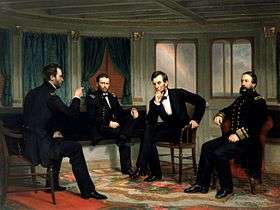
.jpg)
